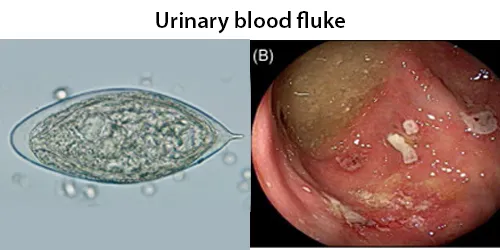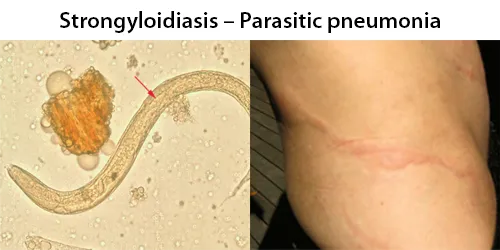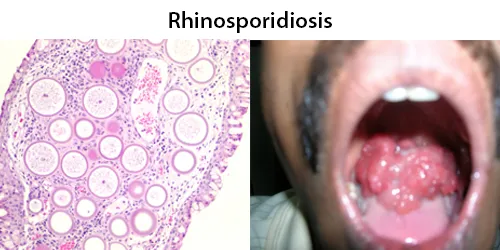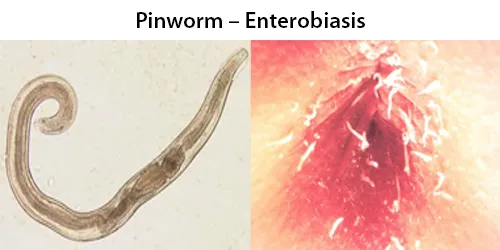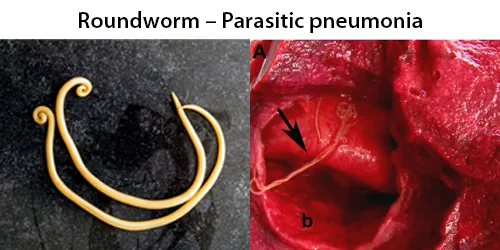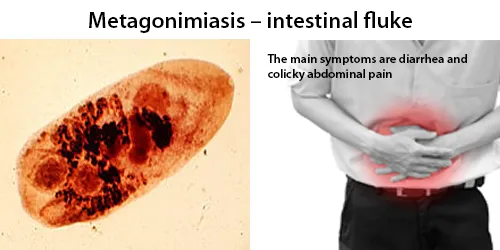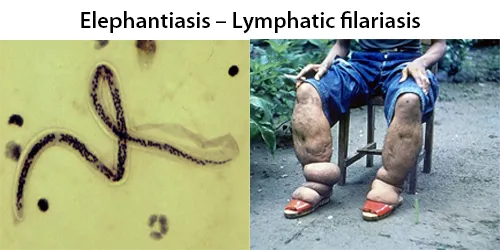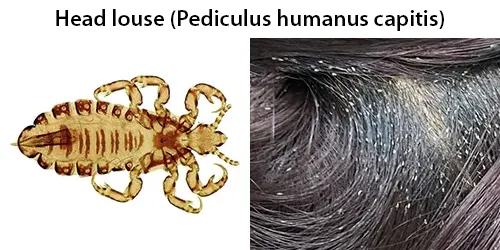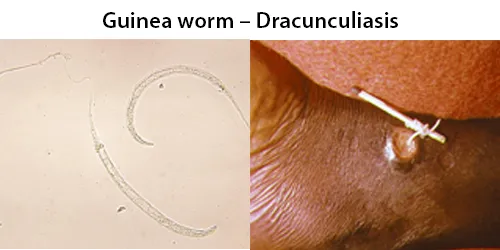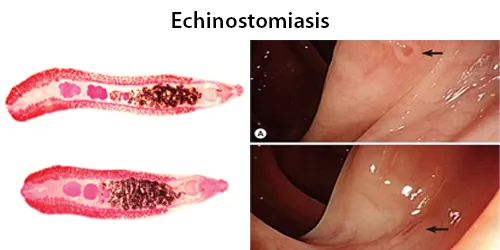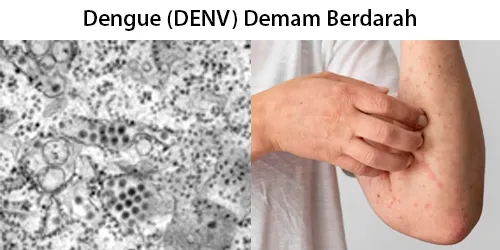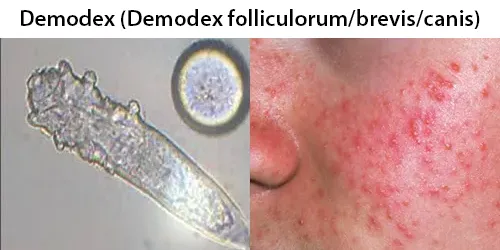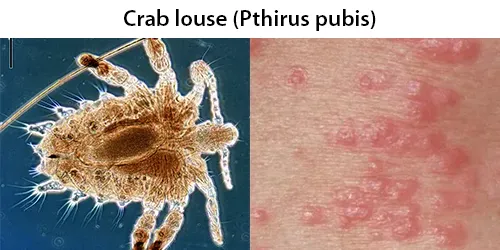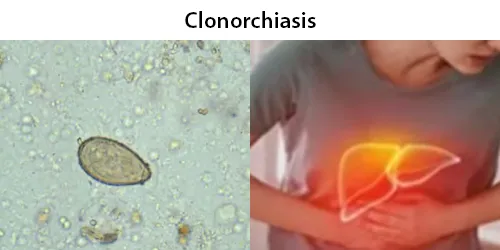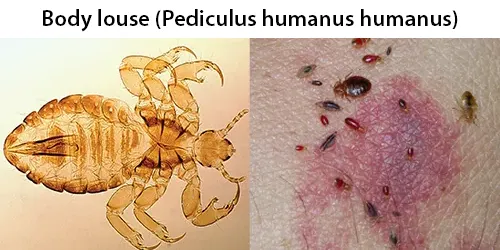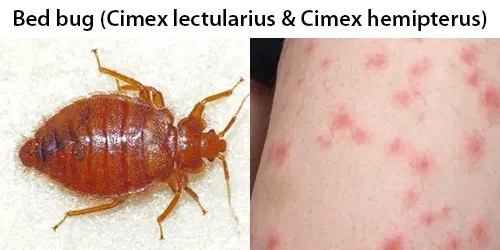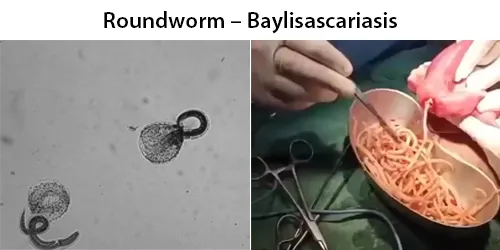Program Deep Dive Parasit & Penyakit Serta Terapinya
BSI International Clinics menawarkan pengujian untuk berbagai penyakit parasit yang tidak diujikan di tempat lain.
Harga Perkenalan : Rp. 5.500.000
Karena permintaan yang tinggi, penawaran ini diperpanjang hingga Juli 2025.
Mencakup 94 tes, berdasarkan pemeriksaan kulit dan kulit kepala dengan lensa yang sangat mendetail, tes mikroskopis dan/atau rapid tes, urine, dan feses untuk parasit dan patogen, serta analisis penyakit yang mungkin ditimbulkannya.
Semua itu hanya ada di kepala Anda
mungkin orang sering berkata demikian.
Terkadang kita mengalami penyakit yang tidak dapat kita temukan penyebab atau alasannya.
Jika Anda adalah seseorang yang bepergian ke daerah tropis, makan makanan jalanan, mengonsumsi makanan mentah, pernah digigit serangga tropis, melakukan hubungan intim saat bepergian, terpapar hewan peliharaan dan hewan liar, atau mandi di sungai atau di area muara laut — dan keadaan anda mulai tidak baik sejak saat itu, maka mungkin saja Anda telah menjadi inang bagi parasit tertentu.
Sepanjang hidup, kita terpapar patogen dan parasit yang mungkin lama tersembunyi dalam tubuh (terutama di daerah tropis — tetapi juga tidak menutup kemungkinan di iklim yang lain), yang mungkin atau mungkin tidak muncul atau berhari-hari atau bahkan bertahun-tahun. Terkadang kita terpapar patogen ini, tetapi tidak menunjukkan tanda-tanda infeksi secara nyata. Mungkin pertumbuhan aneh itu bukan kanker, tetapi sebenarnya kista tempat tersimpannya parasit…
Banyak patogen yang diuji di sini tetap terpendam dalam tubuh, beberapa patogen terpendam selama bertahun-tahun — dan kerap mulai muncul saat stres berat, atau saat patogen terbangun dari dormansi akibat trauma seperti vaksinasi, emosi berat, kecelakaan fisik — dan masih banyak lagi.
BSI International Clinics menawarkan pengujian untuk berbagai penyakit parasit yang tidak diujikan di tempat lain. Dan untuk sebagian besar dari penyakit yang kita temukan, dapat kami tawarkan dengan pengobatan alami, serta pengobatan konvensional yang aman di beberapa kasus lain. Banyak dari patogen ini dapat tetap terpendam dalam tubuh selama bertahun-tahun, bahkan seumur hidup.
Buatlah pilihan yang tepat.
Hindari penyakit yang merugikan anda di masa depan.
BSI International Clinics. Biarkan terapi alami di mulai
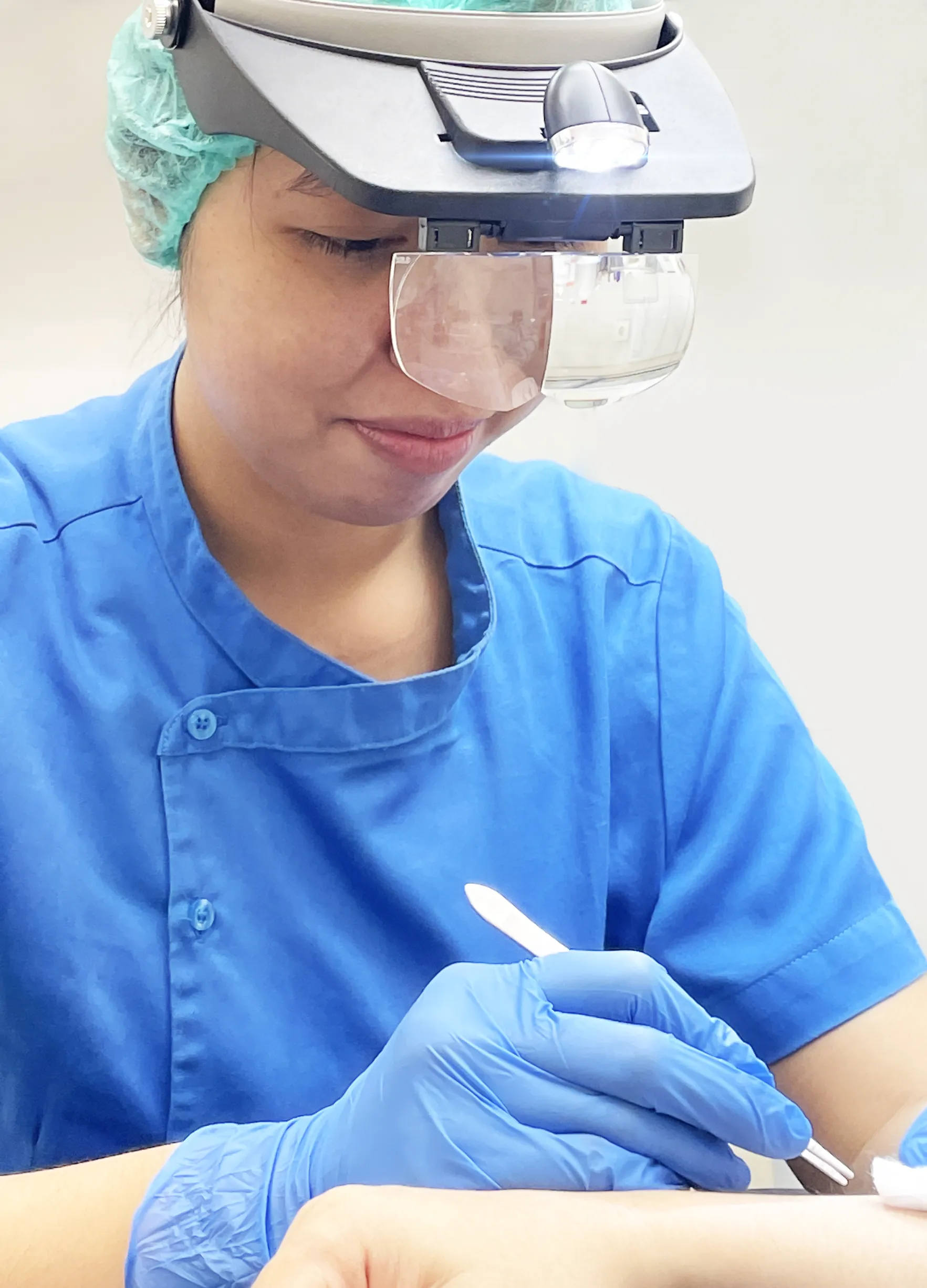
Yang Anda Dapatkan di Deep Dive
Program Deep Dive Parasit & Penyakit Serta Pengobatannya
Mencakup 94 tes, berdasarkan pemeriksaan kulit dan kulit kepala dengan lensa yang sangat mendetail, tes mikroskopis dan/atau rapid tes, urine, dan feses untuk parasit dan patogen, serta analisis penyakit yang mungkin ditimbulkannya.
Biaya untuk pengujian saja : Rp. 7.000.000
Terapi, jika diresepkan, adalah tambahan. Biaya bervariasi, tergantung pada resep. Keanggotaan BSI diperlukan, termasuk Program BSI Signature Evidence-Based.
Harga Perkenalan : Rp. 5.500.000
Karena permintaan yang tinggi, penawaran ini diperpanjang hingga Juli 2025.
Hasil Tes Ekstensif Dengan Foto
* Analisis lengkap dari semua 94 tes didokumentasikan dalam laporan 10-20 halaman, lengkap dengan foto dan penjelasan menyeluruh dari tes.
* Laporan ini diserahkan kepada pasien, dijelaskan halaman demi halaman. Resep termasuk di akhir, jika diperlukan.
* Daftar parasit dan patogen yang teramati dan tidak teramati.
* Termasuk pemeriksaan ekstensif kulit dan kulit kepala dengan foto dan analisis pengamatan.
* Diseksi feses lengkap (bukan hanya sebagian sampel seperti pengujian lain)
* Observasi mikroskopis feses, urine, dan darah dengan foto dan analisis pengamatan.
* Referensi kanker dasar yang disebabkan oleh parasit. Jika referensi kanker teramati, kami mungkin menyarankan pemeriksaan penanda tumor atau terapi lainnya.
Resep atau Rujukan Spesifik, Jika Diperlukan
Sebagian besar infeksi parasit dapat diobati di BSI. Namun, mereka yang mungkin memerlukan pembedahan dapat dirujuk.
Akses Email ke Staf Medis BSI
Anda dapat mengajukan pertanyaan tentang terapi Anda selama jam kerja normal melalui email balasan.
Parasit dan Patogen yang Diuji
- Tes Cepat Laboratorium Termasuk
• Adenovirus / Rotavirus
Periode Dormansi: 2-19 hari, dapat luruh selama berbulan-bulan setelah gejala berhenti.
Infeksi adenovirus sering muncul sebagai konjungtivitis, tonsilitis (yang mungkin tampak persis seperti radang tenggorokan streptokokus dan tidak dapat dibedakan dari streptokokus kecuali melalui kultur tenggorokan), infeksi telinga, atau croup. Adenovirus juga dapat menyebabkan gastroenteritis. Kombinasi konjungtivitis dan tonsilitis sangat umum terjadi pada infeksi adenovirus. Sebagian besar infeksi adenovirus menyebabkan infeksi saluran pernapasan atas.
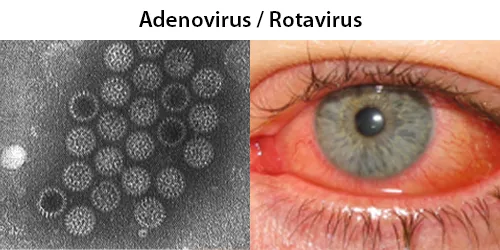
• Avian Flu (IAV) / Flu Burung
Periode Dormansi: 2 hari, namun beberapa orang mungkin tidak menunjukkan gejala dan dapat menularkan virus selama berminggu-minggu.
Influenza Avian, juga dikenal sebagai flu burung, adalah penyakit yang disebabkan oleh virus influenza A (IAV) yang terutama menyerang burung tetapi kadang-kadang dapat memengaruhi mamalia termasuk manusia. Jarang sekali, manusia bisa terinfeksi flu burung jika mereka berada dalam kontak dekat dengan burung yang terinfeksi.
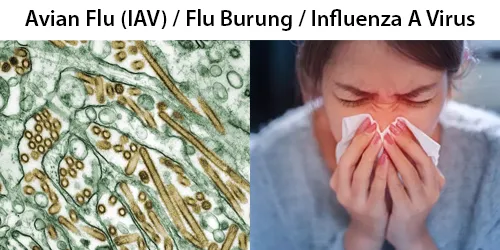
• Brucella
Periode Dormansi: Hingga 6 minggu, ditambah dengan kerusakan negatif seumur hidup.
Setelah terpapar bakteri Brucella, manusia umumnya memiliki periode laten dua hingga empat minggu sebelum menunjukkan gejala, yang meliputi demam bergelombang akut (>90% dari semua kasus), sakit kepala, artralgia (>50%), keringat malam, kelelahan, dan anoreksia. Komplikasi selanjutnya dapat meliputi arthritis atau epididimo-orchitis, spondilitis, neurobrucellosis, pembentukan abses hati, dan endokarditis, yang terakhir dapat berakibat fatal.

• Chikungunya (CHIKV)
Masa dormansi: Hingga 12 hari, beberapa orang tidak menunjukkan gejala tetapi dapat tetap terinfeksi selama satu tahun atau lebih.
Chikungunya adalah penyakit yang ditularkan ke manusia oleh nyamuk di Afrika, Asia, dan Amerika. Anda tidak dapat tertular dari orang lain, tetapi nyamuk dapat menularkannya dengan menggigit orang yang terinfeksi. Kebanyakan orang tidak meninggal karenanya.
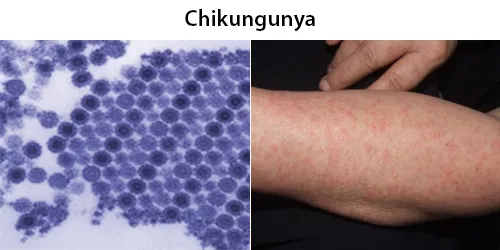
• Cholerae / Vibrio Cholera / Kolera
Masa dormansi: Gejala mulai timbul 12 jam hingga 5 hari setelah terpapar
Kolera adalah infeksi parah pada usus kecil oleh beberapa jenis bakteri Vibrio cholerae, yang ditularkan melalui konsumsi makanan atau air yang terkontaminasi. Diperlukan waktu antara 12 jam hingga 5 hari bagi seseorang untuk menunjukkan gejalanya. Kolera dapat menyebabkan diare dan dehidrasi yang sangat parah yang dapat membunuh dalam hitungan jam jika tidak ditangani. Ikan dan makanan mentah merupakan sumber umum penyakit ini. Sebagian besar dari mereka yang terinfeksi tidak memiliki gejala atau gejala ringan.
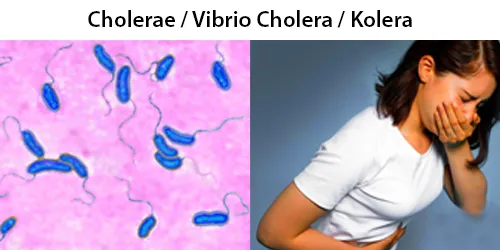
• Dengue (DENV) / Demam Berdarah
Periode Dormansi : Hingga 14 hari. Hingga 80% tidak menunjukkan gejala
Demam berdarah adalah penyakit yang bisa Anda alami dari gigitan nyamuk yang membawa salah satu dari empat jenis Dengue. Demam berdarah tidak menular dari orang ke orang kecuali jika ditularkan dari ibu hamil kepada anaknya. Gejala biasanya ringan pada infeksi pertama, tetapi infeksi berulang dengan versi demam berdarah yang berbeda, risiko komplikasi yang parah akan meningkat.

• Ebola
Masa dormansi: 2 hari hingga 3 minggu. Pasien dapat terus menular selama beberapa bulan setelah sembuh.
Ebola, yang juga dikenal sebagai penyakit virus Ebola (EVD) dan demam berdarah Ebola (EHF), adalah demam berdarah virus pada manusia dan primata lainnya, yang disebabkan oleh ebolavirus. Gejala biasanya dimulai antara dua hari hingga tiga minggu setelah infeksi. Gejala pertama biasanya berupa demam, sakit tenggorokan, nyeri otot, dan sakit kepala. Hal ini biasanya diikuti dengan muntah, diare, ruam dan penurunan fungsi hati dan ginjal, di mana beberapa orang mulai mengalami pendarahan baik secara internal maupun eksternal.
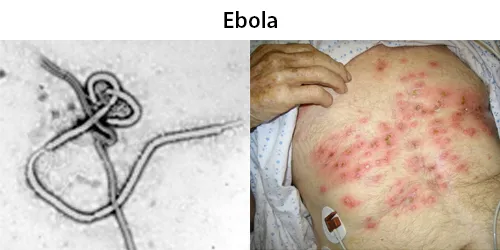
• E. Coli
Masa dormansi: Hingga 10 hari untuk jenis yang beracun. Strain yang menguntungkan bertahan seumur hidup.
Sebagian besar strain E. coli tidak berbahaya, tetapi beberapa serotipe seperti EPEC, dan ETEC bersifat patogen dan dapat menyebabkan keracunan makanan yang serius pada inangnya, dan kadang-kadang menjadi penyebab atas kontaminasi makanan.

• Tes Darah Okultisme Feses
Tes darah okultisme tinja adalah skrining yang mencari darah tersembunyi (okultisme) dalam tinja (kotoran). Tes ini dapat mengidentifikasi jejak kecil darah yang tidak dapat Anda lihat sendiri. Tes ini membantu penyedia layanan kesehatan mendiagnosis beberapa kondisi kesehatan.
Apa yang ditunjukkan oleh tes darah okultisme tinja?
Darah dalam tinja berarti ada pendarahan yang terjadi di suatu tempat di saluran pencernaan Anda. Jenis pendarahan ini tidak normal dan biasanya merupakan tanda kondisi kesehatan, seperti:
- Anemia, ketika tubuh Anda tidak memiliki cukup sel darah merah yang sehat.
- Kolitis, peradangan atau iritasi pada usus besar Anda.
- Kanker kolorektal, kanker yang terjadi pada bagian bawah usus besar atau rektum.
- Divertikulosis, area yang melebar dan seperti gelembung pada dinding usus besar Anda.
- Wasir, pembuluh darah vena yang membengkak di dalam rektum atau di luar anus.
- Polip usus besar, pertumbuhan yang datar, terangkat atau seperti tangkai pada lapisan usus besar atau rektum.
- Ulkus, luka yang berkembang dalam saluran pencernaan atau rektum.
• Hantavirus CriCon HF
Masa dormansi: Hingga 8 minggu
Hantavirus adalah keluarga virus yang disebarkan terutama oleh hewan pengerat melalui hirupan. Virus ini dapat menyebabkan penyakit serius atau kematian pada manusia. Sebagian besar hantavirus tidak ditularkan dari orang ke orang. Spektrum penyakit yang terkait dengan infeksi hantavirus meliputi demam berdarah dengan sindrom ginjal (HFRS) dan sindrom paru hantavirus (HPS) yang juga dikenal sebagai sindrom kardiopulmoner hantavirus (HCPS).
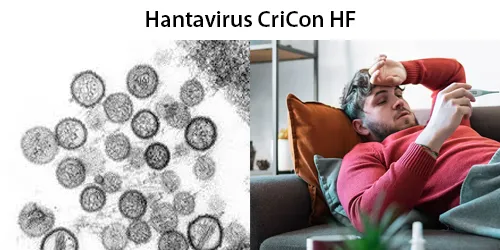
• Helicobacter pylori
Masa dormansi: Hingga seumur hidup pasien.
Gangguan lambung akibat infeksi dimulai dengan gastritis, peradangan pada lapisan lambung. Bila infeksi terus berlanjut, peradangan yang berkepanjangan akan menjadi gastritis kronis. Pada awalnya ini adalah gastritis non-atrofi, tetapi kerusakan yang terjadi pada lapisan lambung dapat menyebabkan perubahan menjadi gastritis atrofi, dan berkembangnya tukak baik di dalam lambung itu sendiri maupun di dalam duodenum, bagian terdekat dari usus.
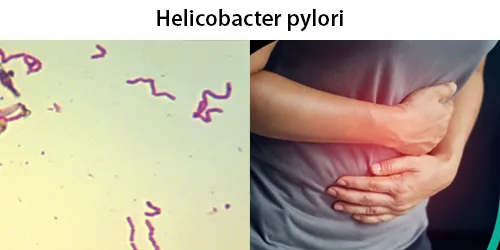
• Leishmaniasis
Masa Dormansi: Beberapa hari hingga beberapa minggu hingga beberapa bulan.
Leishmaniasis adalah beragam manifestasi klinis yang disebabkan oleh parasit protozoa dari genus Trypanosomatida, yaitu Leishmania. Penyakit ini umumnya menyebar melalui gigitan lalat pasir phlebotomine, Phlebotomus dan Lutzomyia, dan paling sering terjadi di daerah tropis dan sub-tropis di Afrika, Asia, Amerika, dan Eropa selatan. Penyakit ini dapat muncul dalam tiga cara utama: kulit, mukosa, atau viseral. Bentuk kutaneus muncul dengan borok kulit, sedangkan bentuk mukokutaneus muncul dengan borok pada kulit, mulut, dan hidung.
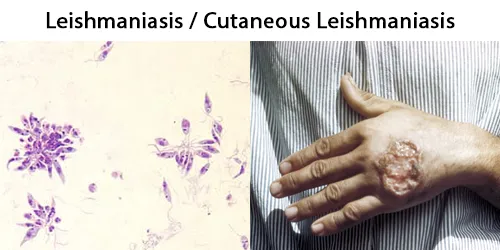
• Leptospirosis
Masa dormansi: 2-4 minggu.
Leptospirosis adalah infeksi darah yang disebabkan oleh bakteri Leptospira yang dapat menginfeksi manusia, anjing, hewan pengerat, dan banyak hewan liar dan hewan peliharaan lainnya. Tanda dan gejalanya dapat berkisar dari tidak ada hingga ringan (sakit kepala, nyeri otot, dan demam) hingga parah (pendarahan di paru-paru atau meningitis). Penyakit Weil, bentuk akut dan parah dari leptospirosis, menyebabkan orang yang terinfeksi menjadi sakit kuning (kulit dan mata menjadi kuning), mengalami gagal ginjal, dan mengalami pendarahan.
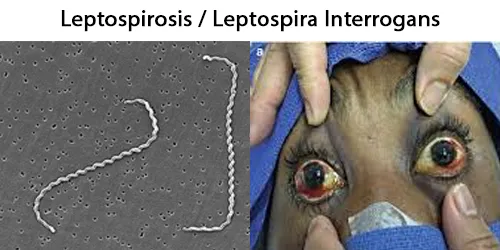
• Lymphatic Filariasis (LF) / Elephantiasis
Masa Dormansi: 1 hingga 8 tahun,
Larva berkembang menjadi cacing dewasa selama satu tahun, dan selama itu pasien dapat tidak menunjukkan gejala, dan mencapai kematangan seksual dalam pembuluh limfatik aferen. Cacing dapat hidup selama kurang lebih 6-8 tahun dan, selama masa hidupnya, menghasilkan jutaan mikrofilaria (larva yang belum matang) yang beredar di dalam darah. Setelah kawin, cacing betina dewasa dapat menghasilkan ribuan mikrofilaria yang bermigrasi ke dalam aliran darah.
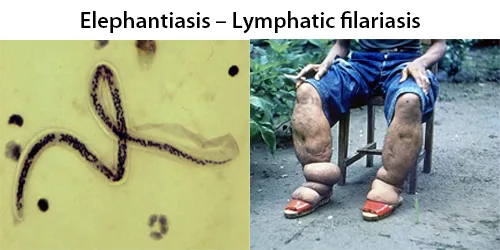
• Malaria
Masa Dormansi: Hingga 24 minggu setelah gejala awal.
Malaria pada manusia disebabkan oleh mikroorganisme bersel tunggal dari kelompok Plasmodium. Penyakit ini disebarkan secara eksklusif melalui gigitan nyamuk Anopheles betina yang terinfeksi. Gigitan nyamuk memasukkan parasit dari air liur nyamuk ke dalam darah seseorang. Parasit berjalan ke hati, di mana mereka menjadi dewasa dan berkembang biak.
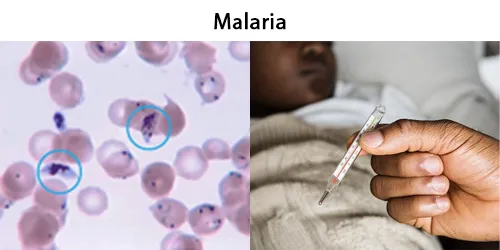
• Monkeypox
Masa dormansi: Hingga 4 minggu.
Informasi berikut ini adalah informasi yang bias dari CDC. Cacar monyet adalah virus zoonosis yang termasuk dalam genus Orthopoxvirus, sehingga memiliki hubungan yang erat dengan virus variola, cacar sapi, dan vaksinia. Gejala cacar monyet pada manusia meliputi ruam yang membentuk lepuhan dan kemudian mengeras, demam, dan pembengkakan kelenjar getah bening. Virus ini dapat ditularkan antara hewan dan manusia melalui kontak langsung dengan lesi atau cairan tubuh.
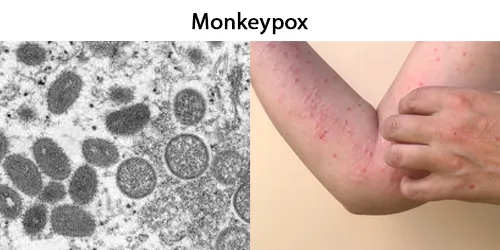
• Rabies (RABV) / Penyakit Anjing Gila
Masa dormansi: Biasanya hingga 3 bulan. Masa ini dapat berlangsung selama empat hari atau lebih dari enam tahun, tergantung pada lokasi dan tingkat keparahan luka serta jumlah virus yang masuk.
Rabies adalah penyakit zoonosis (lompatan dari hewan ke manusia) yang disebabkan oleh infeksi virus dari genus Lyssavirus, yang ditularkan melalui air liur hewan yang terinfeksi. Anjing adalah inang terpenting untuk virus rabies, dan gigitan anjing menyumbang >99% dari kasus rabies pada manusia. Ketika seseorang yang terkena rabies mengalami gejala, penyakit ini hampir selalu berakibat fatal.
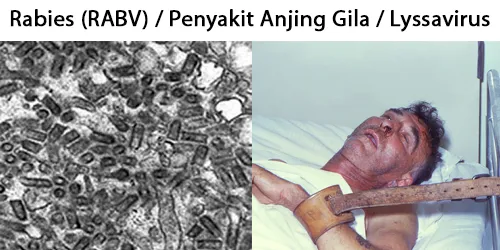
• Rubella / Campak Jerman
Masa dormansi: Hingga 23 hari.
Rubella, atau campak Jerman atau demam scarlet, adalah infeksi virus ringan yang biasanya terjadi pada anak-anak dan orang dewasa muda yang tidak memiliki kekebalan tubuh. Rubella sangat menular dari orang ke orang, ditularkan terutama melalui kontak langsung atau tetesan dari sekresi nasofaring. Manusia adalah satu-satunya inang alami.
Masa inkubasi rata-rata virus rubella adalah 12 hingga 23 hari. Orang yang terinfeksi rubella paling mudah menular saat ruamnya muncul. Namun, mereka dapat menular dari 7 hari sebelum hingga 7 hari setelah ruam muncul. Sekitar 25% hingga 50% infeksi tidak menunjukkan gejala.
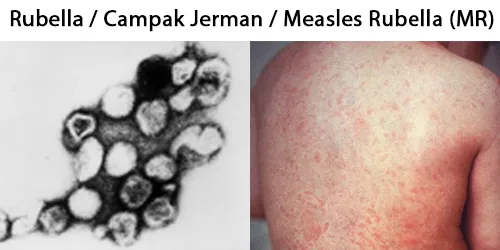
• Salmonellosis / Salmonella Typhimurium
Masa dormansi: Dari 6 jam hingga 6 hari, dan hingga beberapa minggu.
Salmonella adalah patogen bakteri yang menyebabkan Salmonellosis. Bakteri Salmonella biasanya hidup di usus hewan dan manusia dan dikeluarkan melalui tinja. Manusia paling sering terinfeksi melalui air atau makanan yang terkontaminasi. Salmonella terkenal karena kemampuannya untuk bertahan hidup dari kekeringan dan dapat bertahan selama bertahun-tahun di lingkungan dan makanan yang kering. Gejala biasanya dimulai enam jam hingga enam hari setelah infeksi dan berlangsung selama empat hingga tujuh hari.
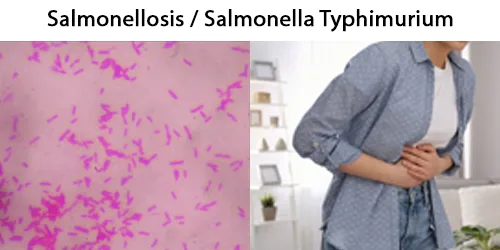
• Scrub Typhus
Masa dormansi: Hingga 12 hari.
Scrub typhus adalah penyakit yang ditularkan melalui tungau yang disebabkan oleh bakteri yang dikenal sebagai Orientia tsutsugamushi dan ditularkan oleh chigger – larva yang tumbuh menjadi tungau, di daerah pedesaan dan daerah berhutan di wilayah Asia-Pasifik. Chigger sering kali terjangkit bakteri ketika mereka memakan sel-sel kulit tikus atau tikus yang terinfeksi. Bakteri ini dapat menyebabkan demam, kesulitan bernapas, jantung berdebar-debar, atau kematian jantung mendadak. Masa inkubasi bakteri di dalam tubuh sekitar 6-10 hari. Gejala dapat muncul secara tiba-tiba sekitar 10-12 hari setelah gigitan.
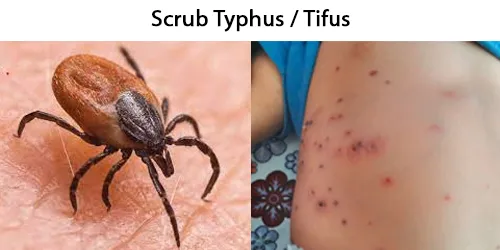
• Trichinosis / Trikinosis
Masa Dormansi: Hingga 7 hari.
Sekitar 11 juta manusia terinfeksi Trichinella. Sebagian besar infeksi trikinosis hanya memiliki gejala ringan atau tanpa gejala dan tanpa komplikasi. Selama infeksi awal, invasi pada usus dapat menyebabkan diare, sakit perut, dan muntah. Migrasi larva ke otot, yang terjadi sekitar seminggu setelah terinfeksi, dapat menyebabkan pembengkakan pada wajah, radang bagian putih mata, demam, nyeri otot, dan ruam. Komplikasi dapat mencakup radang otot jantung, keterlibatan sistem saraf pusat, dan radang paru-paru.
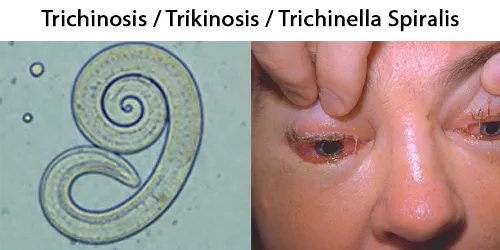
• Trichomonas / Trikomoniasis
Masa Dormansi: Beberapa tahun pada pasien tanpa gejala.
Trichomonas adalah genus parasit gali anaerobik, dan diperkirakan merupakan IMS non-virus yang paling banyak ditemukan di seluruh dunia. Tingkat infeksi pada pria dan wanita serupa, tetapi wanita biasanya bergejala, sedangkan infeksi pada pria biasanya tidak bergejala. Penularan biasanya terjadi melalui kontak langsung dari kulit ke kulit dengan orang yang terinfeksi, paling sering melalui hubungan seksual. 160 juta kasus infeksi terjadi setiap tahunnya di seluruh dunia.
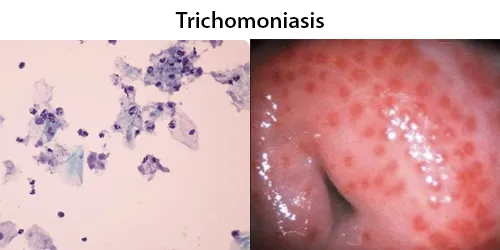
• Toxoplasmosis / Toksoplasmosis
Masa Dormansi: 7-10 hari, atau dalam masa dormansi seumur hidup pasien.
Ditemukan di seluruh dunia, T. gondii mampu menginfeksi hampir semua hewan berdarah panas. Pada manusia, terutama bayi dan mereka yang memiliki kekebalan tubuh yang lemah, infeksi T. gondii umumnya tidak menunjukkan gejala tetapi dapat menyebabkan kasus toksoplasmosis yang serius. T. gondii pada awalnya dapat menyebabkan gejala ringan seperti flu dalam beberapa minggu pertama setelah paparan, tetapi sebaliknya, orang dewasa yang sehat tidak menunjukkan gejala.
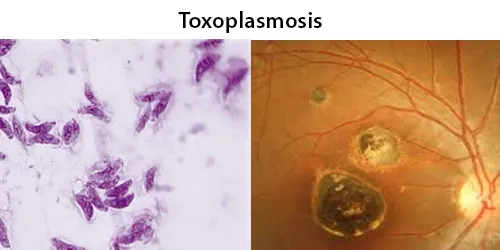
• Demam Tifoid
Masa dormansi: Hingga 30 hari
Uji bersama dengan Rapid test Salmonella.
Demam tifoid, atau tifus, disebabkan oleh bakteri Salmonella enterica serotipe Typhi, juga disebut Salmonella typhi. Tifus biasanya menyebar melalui konsumsi makanan atau air yang terkontaminasi. Gejalanya bervariasi dari ringan hingga berat, dan biasanya dimulai enam hingga 30 hari setelah terpapar.
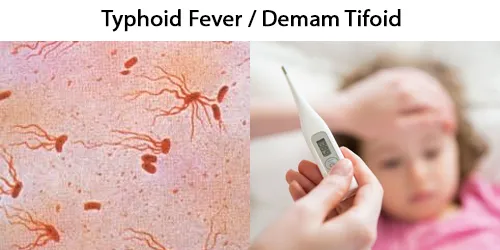
• Demam Kuning
Masa dormansi: 3-6 hari
Penyakit ini disebabkan oleh virus demam kuning dan disebarkan oleh gigitan nyamuk yang terinfeksi. Penyakit ini menginfeksi manusia, primata lain, dan beberapa jenis nyamuk, disebarkan terutama oleh Aedes aegypti, sejenis nyamuk yang ditemukan di seluruh daerah tropis dan subtropis.
Demam kuning adalah penyakit virus yang biasanya berdurasi pendek. Pada kebanyakan kasus, gejalanya meliputi demam, menggigil, kehilangan nafsu makan, mual, nyeri otot-terutama di bagian punggung-dan sakit kepala.
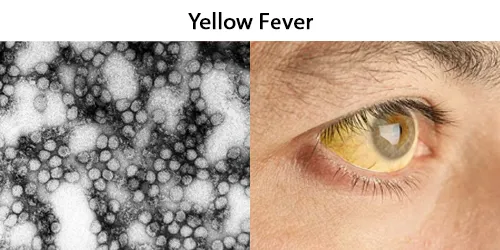
• Zika Virus
Masa dormansi: Hingga enam bulan – periksalah sebelum kehamilan.
Zika adalah flavivirus yang ditularkan oleh nyamuk yang dapat menyebabkan cacat bawaan, termasuk mikrosefali. Zika menyebabkan gejala yang mirip dengan penyakit virus lainnya yang disebarkan melalui gigitan nyamuk, seperti demam berdarah dan chikungunya. Banyak orang yang terinfeksi virus Zika tidak akan mengalami gejala atau hanya mengalami gejala ringan. Jarang sekali, infeksi Zika dapat menyebabkan sindrom Guillain-Barré (GBS) atau penyakit parah yang menyerang otak. Sebagian besar infeksi virus Zika tidak menunjukkan gejala.
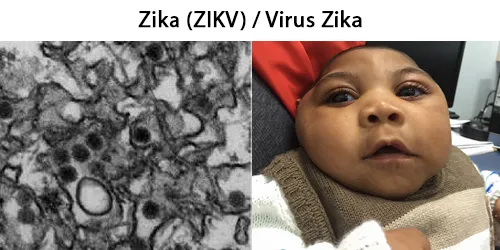
- Fluke
• Schistosomiasis Usus Asia
Periode Dormansi: Hingga 8 minggu.
Perkiraan angka kematian tahunan dan risiko infeksi masing-masing adalah 280.000 dan 732 juta kasus di seluruh dunia. Schistosomula beredar dalam darah inang dan berkembang menjadi dewasa. Cacing dewasa melepaskan telur ke dalam aliran darah yang kemudian terjebak di kapiler kecil usus atau kandung kemih, menembus dindingnya, dan dilepaskan melalui tinja atau urin. Siklus ini kemudian terulang kembali.
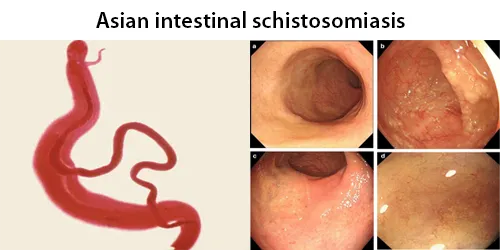
• Cacing Hati Tiongkok
Masa Dormansi: Infeksi dapat berlangsung seumur hidup.
Metaserkaria bebas menembus mukosa usus dan masuk ke saluran empedu. Migrasi ke dalam saluran empedu membutuhkan waktu 1-2 hari. Mereka mulai memakan empedu yang dikeluarkan dari hati, dan secara bertahap tumbuh. Mereka menjadi dewasa dalam waktu sekitar satu bulan, dan mulai bertelur. Umur rata-rata seekor cacing dewasa adalah 30 tahun. Seekor cacing dapat menghasilkan 4.000 telur dalam sehari.
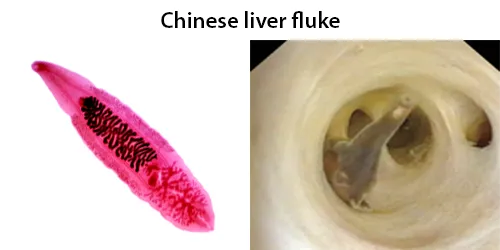
• Clonorchiasis
Masa Dormansi: Hingga 25 tahun.
Clonorchiasis merupakan penyakit endemik di Timur Jauh, terutama di Korea, Jepang, Taiwan, dan Cina Selatan. Infeksi ini terjadi setelah menelan ikan air tawar yang kurang matang atau diawetkan yang diimpor dari salah satu daerah endemik dan mengandung metaserkaria. Manusia menjadi terinfeksi dengan memakan ikan yang terinfeksi yang telah dimasak setengah matang, diasapi, atau diasinkan. Cacing C. sinensis dewasa dapat menghuni saluran empedu manusia selama 20-25 tahun tanpa gejala klinis yang jelas.
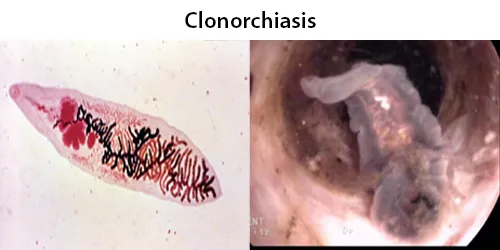
• Echinostomiasis
Masa Dormansi: Hingga 5 bulan.
Telur Echinostoma dapat bertahan hidup selama sekitar 5 bulan dan masih memiliki kemampuan untuk menetas dan berkembang ke tahap siklus hidup berikutnya. Infeksi dapat menyebabkan penyakit yang disebut echinostomiasis. Cacing dengan nama E. revolutum, E. echinatum, E. malaynum dan E. hortense merupakan penyebab umum infeksi Echinostoma pada manusia.

• Fasciolopsiasis – Cacing Usus
Masa Dormansi: Hingga 2 bulan.
Gejala biasanya dimulai 30 hingga 60 hari setelah terpapar. Sebagian besar infeksi ringan, hampir tanpa gejala. Pada infeksi berat, gejalanya dapat berupa sakit perut, diare kronis, anemia, asites, toksemia, respons alergi, sensitisasi yang disebabkan oleh penyerapan metabolit alergen cacing yang dapat menyebabkan penyumbatan usus dan pada akhirnya dapat menyebabkan kematian pada pasien. Cacing usus terbesar pada manusia, dapat tumbuh hingga 7,5 cm (3,0 inci).
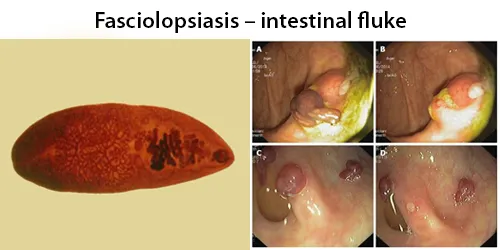
• Schistosomiasis Usus
Masa Dormansi: Hingga 4 minggu.
Pada tahun 2021, Organisasi Kesehatan Dunia (WHO) melaporkan bahwa 251,4 juta orang mengidap schistosomiasis. Sebagai penyebab utama schistosomiasis di dunia, schistosomiasis merupakan parasit yang paling banyak ditemukan pada manusia. Siput adalah inang perantara. Setiap betina bertelur sekitar 300 telur per hari. Schistosomiasis diklasifikasikan sebagai penyakit tropis yang terabaikan.
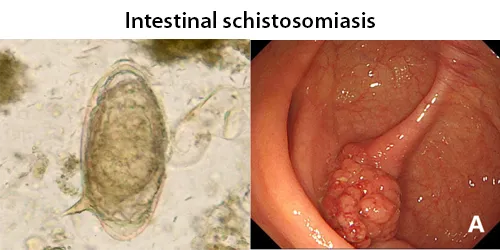
• Cacing Hati
Masa Dormansi: Hingga 2 tahun.
Inang utama untuk Dicrocoelium dendriticum adalah domba, sapi, siput darat, dan semut. Namun, Dicrocoelium dendriticum juga telah ditemukan pada kambing, babi, dan bahkan llama dan alpaka. Infeksi sering kali tidak menunjukkan gejala. Sebagian besar infeksi Dicrocoelium dendriticum pada pohon empedu hanya menimbulkan gejala ringan. Masa inkubasi adalah 1 hari hingga 2 minggu. Dalam lingkungan ini, telur D. dendriticum sangat tahan dan tetap menular hingga 20 bulan. Karena sifat siklus hidup parasit ini yang sangat spesifik, infeksi pada manusia umumnya jarang terjadi.
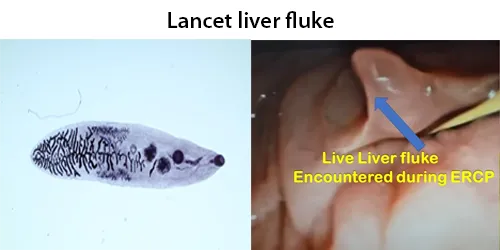
• Cacing Hati – Fasciolosis
Masa Dormansi: Hingga 3 bulan.
Penyakit ini berkembang melalui empat fase yang berbeda; fase inkubasi awal antara beberapa hari hingga tiga bulan dengan sedikit atau tanpa gejala; fase invasif atau akut yang dapat bermanifestasi dengan: demam, malaise, sakit perut, gejala gastrointestinal, urtikaria, anemia, penyakit kuning, dan gejala pernapasan. Penyakit ini kemudian berkembang menjadi fase laten dengan gejala yang lebih sedikit dan akhirnya menjadi fase kronis atau obstruktif beberapa bulan hingga beberapa tahun kemudian.
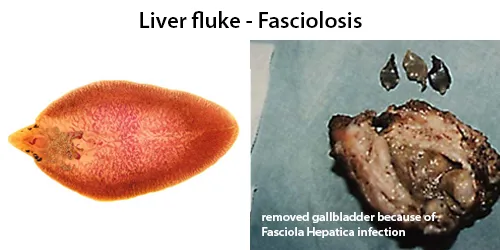
• Metagonimiasis – Cacing Usus
Masa Dormansi: Hingga 14 hari.
Cacing menempel pada dinding usus halus, tetapi sering kali tidak menunjukkan gejala kecuali dalam jumlah besar. Infeksi dapat terjadi karena memakan satu sumber ikan yang terinfeksi. Masa inkubasi sekitar 14 hari dan infestasi dapat bertahan selama lebih dari satu tahun. Pada metagonimiasis akut, manifestasi klinis berkembang hanya 5-7 hari setelah infeksi.
Penularannya membutuhkan dua inang perantara, yang pertama adalah siput, yang paling sering adalah spesies Semisucospira libertina, Semiculcospira coreana, dan Thiara granifera.
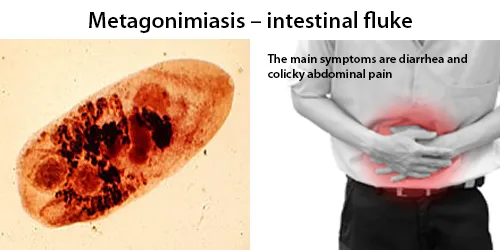
• Metorchiasis
Masa Dormansi: Masa inkubasi sekitar 14 hari dan infestasi dapat bertahan lebih dari satu tahun.
Setelah menelan ikan yang terinfeksi M. conjunctus, dibutuhkan sekitar 1-15 hari untuk memunculkan gejala, yaitu untuk mendeteksi telur dalam feses. Jika tidak diobati, gejala dapat berlangsung dari 3 hari hingga 4 minggu.
Inang perantara pertama M. conjunctus adalah siput air tawar, Amnicola limosus, inang perantara kedua adalah ikan air tawar.
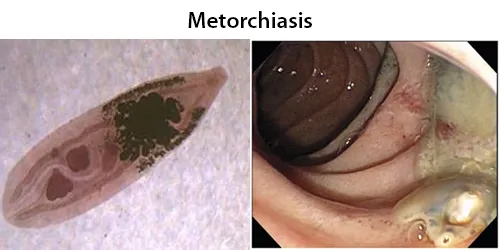
• Paragonimiasis, Cacing Paru-paru
Masa Dormansi: Infeksi dapat bertahan selama 20 tahun atau lebih, dengan sedikit gejala yang jelas, sementara penyakit terkait berkembang.
Sekitar 22 juta orang diperkirakan terkena dampaknya setiap tahun di seluruh dunia. Penyakit ini sangat umum terjadi di Asia Timur. Paragonimiasis mudah disalahartikan sebagai penyakit lain yang memiliki gejala klinis yang sama, seperti tuberkulosis dan kanker paru-paru. Sebagai hermaprodit, mereka memproduksi dan membuahi telur mereka sendiri yang dilepaskan melalui saluran pernapasan.
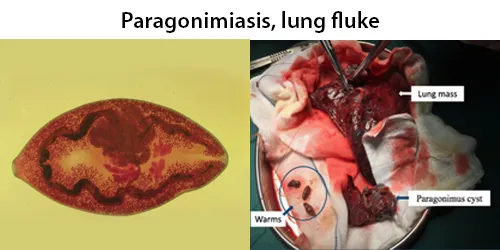
• Schistosomiasis - Bilharzia
Masa Dormansi: 30 tahun atau lebih, dengan sejumlah besar penyakit terkait.
Banyak orang tidak mengalami gejala. Jika gejala muncul, biasanya memerlukan waktu 4-6 minggu sejak terinfeksi. Schistosom dapat hidup rata-rata 3-5 tahun, dan telurnya dapat bertahan hidup selama lebih dari 30 tahun setelah terinfeksi. S. haematobium menyelesaikan siklus hidupnya pada manusia, sebagai inang definitif, dan siput air tawar, sebagai inang perantara, seperti halnya schistosom lainnya. Tetapi tidak seperti schistosom lain yang melepaskan telur di usus, S. haematobium melepaskan telurnya di saluran kemih dan mengeluarkannya bersama urin.
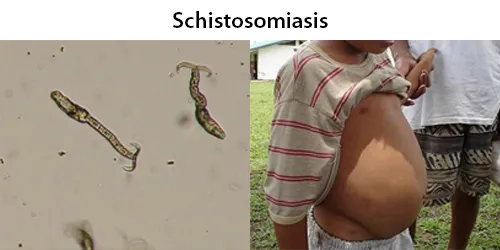
• Schistosomiasis karena Schistosoma japonicum
Masa Dormansi: 30 tahun atau lebih, dengan sejumlah besar penyakit terkait.
Setiap pasang cacing menyimpan sekitar 1500-3500 telur per hari di dalam pembuluh darah di dinding usus. Telur-telur tersebut menyusup melalui jaringan dan dikeluarkan melalui feses. Tingkat keparahan S. japonicum muncul pada 60% dari semua penyakit neurologis pada schistosom karena migrasi telur schistosom ke otak.
Individu yang berisiko terinfeksi S. japonicum adalah petani yang sering mengarungi air irigasi mereka, nelayan yang mengarungi sungai dan danau, anak-anak yang bermain air, dan orang-orang yang mencuci pakaian di sungai.
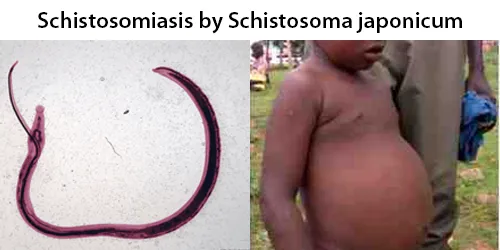
• Swimmer’s itch
Masa Dormansi: Hingga 20 tahun.
Schistosoma (Schistosomatidae) bertanggung jawab atas schistosomosis pada manusia yang menyerang lebih dari 200 juta orang di negara-negara tropis dan subtropis. Patologi sering dikaitkan dengan reaksi inflamasi terhadap telur yang terperangkap di berbagai jaringan/organ tubuh. Telur cacing ini dapat hidup selama 20 tahun dan terus menyebabkan kerusakan. Pada fase awal infeksi, schistosomula yang telah bertransformasi terlokalisasi di kulit. Sebagian besar schistosomula tetap terlokalisasi di sumsum tulang belakang toraks dan serviks dan hanya secara luar biasa bermigrasi ke otak.
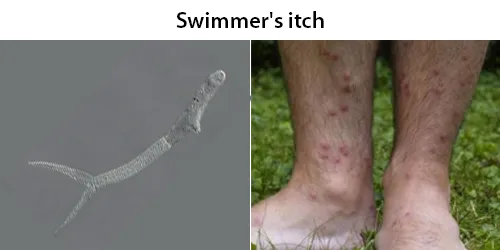
• Urinary blood fluke
Masa Dormansi: 4 tahun atau lebih.
Kematangan seksual dicapai setelah 4-6 minggu infeksi awal. Seekor betina umumnya bertelur 500-1.000 telur dalam sehari. Kutu ini terus menerus bertelur sepanjang hidupnya. Umur rata-rata adalah 3-4 tahun. Cacing dewasa ditemukan di pleksus vena di sekitar kandung kemih dan telur yang dilepaskan bergerak ke dinding kandung kemih yang menyebabkan hematuria dan fibrosis pada kandung kemih. Kandung kemih menjadi kalsifikasi, dan terjadi peningkatan tekanan pada ureter dan ginjal, atau dikenal sebagai hidronefrosis. Peradangan pada alat kelamin akibat S. haematobium dapat berkontribusi pada penyebaran HIV.

- Ektoparasit
• Kutu Kasur
Periode Dormansi: Kutu kasur dapat dorman hingga 12 bulan. Tidak ada penyakit yang ditularkan oleh vektor yang diketahui.
Meskipun mereka menjauh dari inang setelah makan, mereka tetap berada di dalam sarang, tempat bertengger, atau tempat tinggal inang mereka. Mereka dapat dianggap sebagai pemangsa mikro penghisap darah. Kecoak dewasa dilaporkan dapat hidup antara tiga hingga dua belas bulan jika berada dalam situasi rumah tangga yang tidak dirawat.
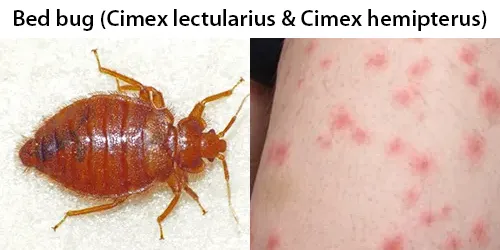
• Kutu Badan – Pedikulosis
Periode Dormansi: Dari patogen yang ditularkan melalui vektor hingga 20 hari.
Kutu badan dapat meletakkan telurnya di rambut dan pakaian inangnya, tetapi pakaian adalah tempat sebagian besar telur biasanya dilekatkan. Patogen yang paling penting yang ditularkan oleh kutu badan adalah Rickettsia prowazekii (penyebab tifus epidemik), Borrelia recurrentis (penyebab demam relapsing), dan Bartonella quintana (penyebab demam parit). Kutu dewasa dapat hidup sekitar tiga puluh hari, tetapi jika terpisah dari inangnya, mereka akan mati dalam waktu dua hari.
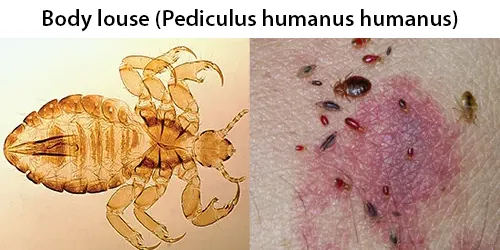
• Chiggers (Trombiculidae) – Trombiculosis
Masa Dormansi: Tifus Lulur, 21 hari
Leptotrombidium deliense dianggap sebagai hama berbahaya di Asia Timur dan Pasifik Selatan karena sering membawa Orientia tsutsugamushi, bakteri kecil yang menyebabkan tifus lulur, yang juga dikenal sebagai penyakit sungai Jepang, penyakit lulur, atau tsutsugamushi. Tungau terinfeksi oleh Rickettsia yang diturunkan dari induk ke anaknya sebelum telur diletakkan dalam proses yang disebut penularan transovarian. Gejala tifus lulur pada manusia meliputi demam, sakit kepala, nyeri otot, batuk, dan gejala pencernaan.
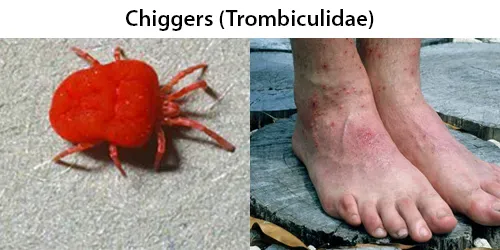
• Kutu Kepiting – Phthiriasis (Kepiting)
Masa Dormansi: Kutu dewasa dapat hidup hingga 30 hari. Tidak ada penyakit yang ditularkan melalui vektor.
Memakan darah, kutu kepiting biasanya ditemukan di rambut kemaluan seseorang. Meskipun kutu ini tidak dapat melompat, kutu ini juga dapat hidup di area tubuh lain yang ditumbuhi rambut kasar, seperti area peri-anal, seluruh tubuh (pada pria), dan bulu mata (pada anak-anak).
Total siklus hidup dari telur hingga dewasa adalah 16-25 hari. Orang dewasa dapat hidup hingga 30 hari. Kutu kepiting memakan darah, dan mengonsumsi darah 4-5 kali sehari.
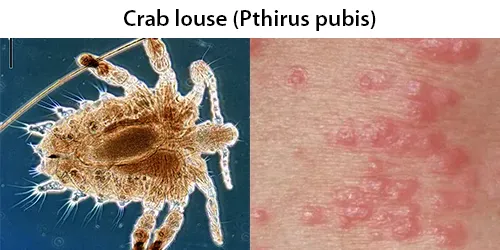
• Demodex – Demodicosis
Periode Dormansi: Umur total tungau Demodex adalah beberapa minggu, dengan penyakit kulit yang berkembang dalam hitungan hari atau bulan.
Demodex canis hidup pada anjing peliharaan, dapat menjadi kudis, dan mudah ditularkan dari anjing ke manusia. Demodicosis paling sering terlihat pada folikulitis (radang folikel rambut pada kulit). Hal ini dapat menyebabkan bintil-bintil kecil (jerawat) di dasar batang bulu pada kulit yang meradang dan tersumbat.
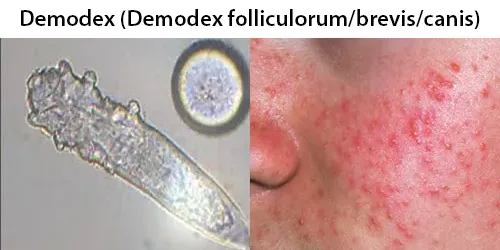
• Flea, jigger
Masa Dormansi: Beberapa bulan tanpa makanan. Banyak vektor berbahaya dapat muncul hingga bertahun-tahun kemudian.
Kutu memakan berbagai macam vertebrata berdarah panas termasuk anjing, kucing, kelinci, tupai, musang, tikus, tikus, burung, dan terkadang manusia. Kutu betina dapat bertelur sebanyak 5000 telur atau lebih selama hidupnya, kutu dewasa hanya hidup selama 2 atau 3 bulan. Tanpa inang untuk menyediakan darah. Kehidupan kutu bisa sesingkat beberapa hari, atau dapat hidup hingga satu setengah tahun, dapat hidup selama beberapa bulan tanpa makan, selama mereka tidak keluar dari kepompongnya.
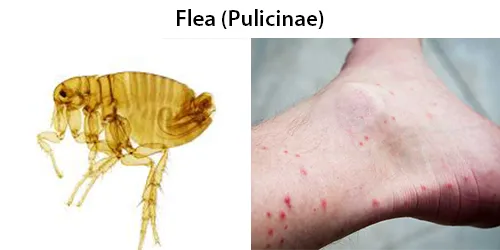
• Kutu Kepala / Pediculosis
Masa Dormansi: Kutu dewasa akan mati dalam waktu 2 hari tanpa makan darah. Vektor langka di Afrika dengan masa inkubasi hingga 20 hari.
Kutu rambut hanya memakan darah manusia dan hanya dapat bertahan hidup pada rambut kepala manusia. Mereka hanya menyebar melalui kontak dari manusia ke manusia. Ketika dewasa, panjangnya sekitar 2 sampai 3 mm. Ketika tidak menempel pada manusia, mereka tidak dapat hidup lebih dari tiga hari.
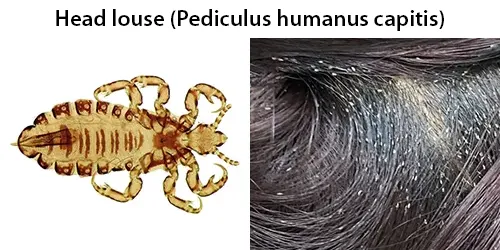
• Tungau Hewan Pengerat
Masa Dormansi: Rickettsialpox umumnya ringan dan sembuh dalam waktu 2-3 minggu jika tidak diobati. Tidak ada kematian yang diketahui akibat penyakit ini.
Tungau ini dapat menularkan penyakit pada manusia, dikaitkan dengan penyebab dermatitis tungau hewan pengerat pada manusia dan tercatat membawa Rickettsia akari, yang menyebabkan cacar air. Tungau hewan pengerat mampu bertahan hidup dalam jangka waktu lama tanpa makan dan melakukan perjalanan jauh ketika mencari inang.
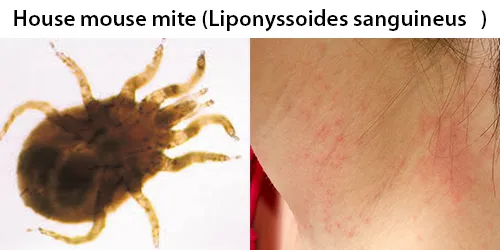
• Nyamuk
Masa Dormansi: Hingga beberapa tahun untuk penyakit yang ditularkan melalui vektor.
Penyakit yang ditularkan oleh nyamuk disebabkan oleh bakteri, virus, atau parasit yang ditularkan oleh nyamuk. Hampir 700 juta orang terjangkit penyakit yang ditularkan oleh nyamuk setiap tahunnya, yang mengakibatkan lebih dari satu juta kematian.
Penyakit yang ditularkan oleh nyamuk termasuk malaria, demam berdarah, virus West Nile, chikungunya, demam kuning, filariasis, tularemia, dirofilariasis, ensefalitis Jepang, ensefalitis Saint Louis, ensefalitis kuda Barat, ensefalitis kuda Timur, ensefalitis kuda Venezuela, demam Sungai Ross, demam Hutan Barmah, ensefalitis La Crosse, dan demam Zika, serta virus Keystone yang baru saja terdeteksi dan demam Lembah Celah.
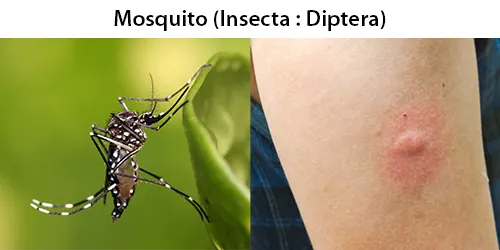
• Gamasoidosis
Masa Dormansi: Hingga bertahun-tahun tergantung pada vektor terkait.
Diagnosis dapat menjadi tantangan karena ukuran tungau unggas yang kecil membuat mereka “nyaris tidak terlihat oleh mata telanjang”. Dermanyssus gallinae juga dapat menginfestasi berbagai bagian tubuh, termasuk saluran telinga dan kulit kepala. Umumnya ditemukan di kamar tidur atau tempat pasien tidur, karena mereka lebih suka tinggal di dekat inangnya untuk mendapatkan makanan yang optimal.
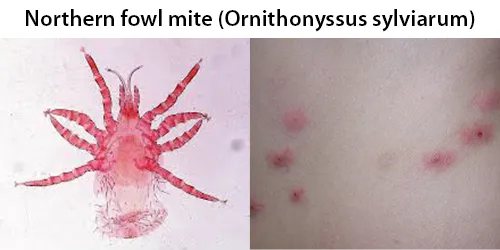
• Kudis
Masa Dormansi: Hingga enam minggu.
Kudis, juga kadang-kadang dikenal sebagai gatal tujuh tahun, adalah infeksi kulit manusia yang menular oleh tungau kecil (0,2-0,45 mm) Sarcoptes scabiei, Pada infeksi pertama, orang yang terinfeksi biasanya mengalami gejala dalam waktu dua hingga enam minggu. Pada infeksi kedua, gejala dapat muncul dalam waktu 24 jam. Tungau masuk ke dalam kulit untuk hidup dan meletakkan telur, gejala kudis disebabkan oleh reaksi alergi terhadap tungau.
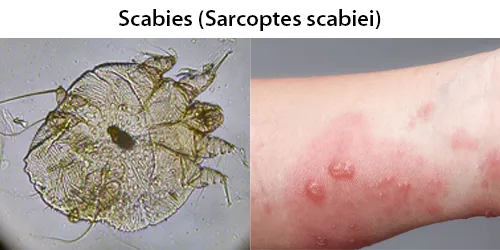
• Kutu
Masa Dormansi: Hingga beberapa tahun, tergantung pada vektornya.
Kutu adalah parasit eksternal, hidup dengan memakan darah mamalia, burung, dan terkadang reptil dan amfibi. Kutu memiliki hingga tujuh tahap nimfa (instar), yang masing-masing membutuhkan konsumsi darah, dan dengan demikian, Kutu menjalani siklus hidup multihost. Karena pola makannya yang hematofag (menelan darah), kutu bertindak sebagai vektor berbagai penyakit serius yang memengaruhi manusia dan hewan lainnya.
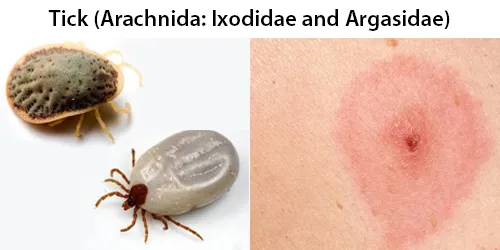
- Cacing Gelang
• Ancylostomiasis / Hookworm
Periode Dormansi: Dapat tetap tidak terdeteksi selama bertahun-tahun, namun anemia dapat menjadi indikator infeksi jangka panjang.
Cacing tambang menyumbang proporsi tinggi penyakit yang melemahkan di daerah tropis dan menyebabkan 50-60.000 kematian per tahun. Cacing ini menyebabkan anemia defisiensi besi dengan menghisap darah dari dinding usus inangnya.
Infeksi biasanya terjadi pada orang yang berjalan telanjang kaki di atas tanah yang terkontaminasi. Dalam menembus kulit, larva dapat menyebabkan reaksi alergi.
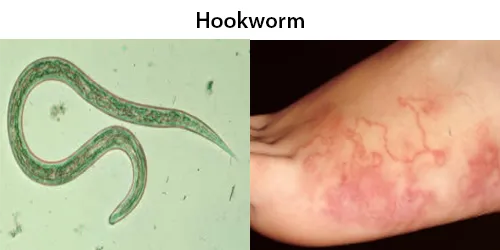
• Angiostrongyliasis
Periode Dormansi: Periode inkubasi pada manusia biasanya dari 1 minggu hingga 47 hari setelah infeksi. Sebagian besar kasus bersifat asimptomatik (tanpa gejala).
Pada manusia, A. cantonensis adalah penyebab paling umum dari meningitis eosinofil atau meningoensefalitis. Seringkali infeksi akan sembuh tanpa pengobatan atau konsekuensi serius, tetapi pada kasus dengan beban parasit yang berat, infeksi dapat begitu parah sehingga dapat menyebabkan kerusakan permanen pada sistem saraf pusat atau bahkan kematian.
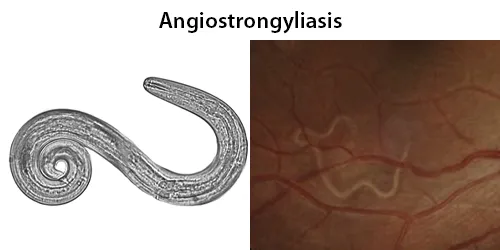
• Anisakiasis
Periode Dormansi: Jika tidak ada reaksi alergi segera, reaksi pencernaan yang lebih parah mungkin dialami dalam beberapa hari.
Anisakiasis adalah infeksi parasit manusia di saluran pencernaan yang disebabkan oleh konsumsi makanan laut mentah atau setengah matang yang mengandung larva nematoda Anisakis simplex. Reaksi ini, yang sebagian besar terlihat sebagai alergi ikan, cenderung terjadi segera setelah konsumsi.
Dalam beberapa jam setelah konsumsi, cacing parasit mencoba menggali melalui dinding usus, tetapi karena tidak dapat menembusnya, ia terjebak dan mati.
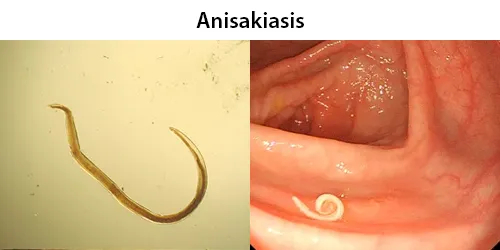
• Cacing Gelang – Parasitic Pneumonia
Masa Dormansi: Hingga 3 tahun.
Seringkali, orang tidak menunjukkan gejala yang jelas tetapi mungkin menderita masalah usus. Ketika gejala muncul, orang tersebut biasanya terinfeksi cacing dalam jumlah besar. Ascaris lumbricoides adalah salah satu patogen yang paling sulit untuk dibunuh (kedua setelah prion), dan telur-telurnya biasanya dapat bertahan hidup selama 1-3 tahun sebelum menetas.
Cacing gelang A. lumbricoides hidup di dalam usus tempat ia bertelur. Infeksi terjadi ketika telur-telur yang terlalu kecil untuk dilihat dengan mata telanjang termakan. Telur-telur tersebut dapat menempel pada sayuran jika tidak dicuci dengan benar.
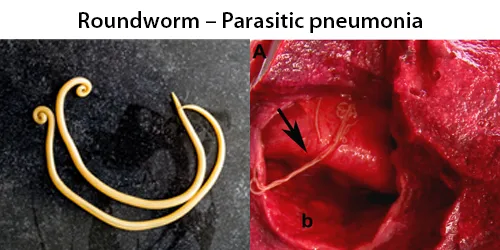
• Cacing Gelang – Baylisascariasis
Periode Dormansi: Beberapa tahun tanpa gejala.
Kebanyakan orang tidak menunjukkan gejala kecuali terinfeksi berat. Infeksi manusia dengan Baylisascaris procyonis relatif jarang. Namun, penyakit yang disebabkan oleh parasit ini bisa sangat berbahaya, menyebabkan kematian atau gejala yang parah. Parasit ini telah diketahui menginfeksi lebih dari 90 jenis hewan liar dan domestik. Penyakit yang dilaporkan terutama menyerang anak-anak, dan hampir semua kasus merupakan akibat penelanan tanah atau feses yang terkontaminasi, melalui rute fekal-oral.
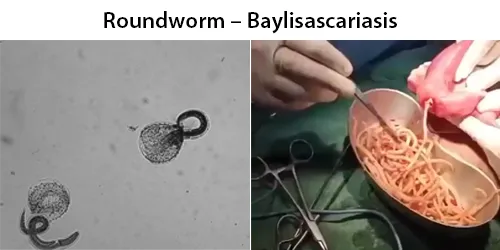
• Cacing Gelang - lymphatic filariasis
Masa Dormansi: 1 bulan sampai 2 tahun.
Masa inkubasi infeksi berkisar antara 1 bulan hingga 2 tahun dan biasanya mikrofilaria muncul sebelum gejala-gejala yang nyata, akumulasi dari banyak gigitan nyamuk yang infektif – beberapa ratus hingga ribuan – diperlukan untuk membentuk infeksi. Limfedema dapat berkembang dalam waktu enam bulan dan perkembangan kaki gajah telah dilaporkan dalam waktu satu tahun setelah infeksi. Pria cenderung mengalami gejala yang lebih buruk daripada wanita. Nyamuk Brugia menyuntikkan larva ke dalam aliran darah manusia. Cacing dewasa dapat bertahan hidup dalam sistem limfatik selama 5-15 tahun. Diperlukan akumulasi banyak gigitan nyamuk untuk menimbulkan infeksi.
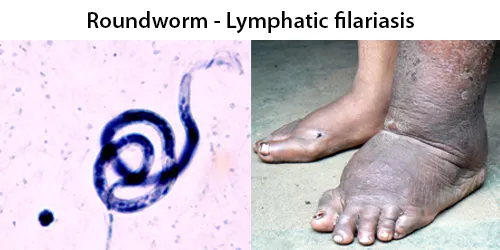
• Cacing Besar Ginjal
Masa Dormansi: Hingga 50 hari.
Setelah dewasa selama kurang lebih 50 hari, larva kemudian bermigrasi ke ginjal (biasanya ginjal kanan). Setelah dewasa, D. renale dapat bertahan hidup selama lima tahun. D. renale tersebar di seluruh dunia, tetapi kurang umum ditemukan di Afrika dan Oseania. Cacing ini menyerang mamalia pemakan ikan, terutama cerpelai, serigala, anjing hutan, rubah, anjing, rakun, dan musang. Infestasi pada manusia jarang terjadi, tetapi dapat menyebabkan kerusakan ginjal.
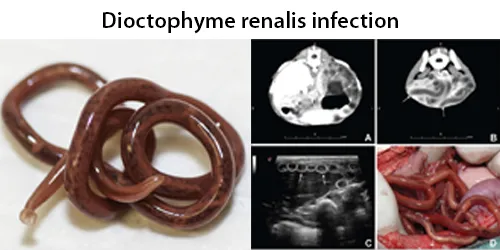
• Infeksi Ophidascaris Robertsi
Masa Dormansi: Mungkin berhari-hari hingga bertahun-tahun.
Ophidascaris robertsi adalah nematoda (juga dikenal sebagai cacing gelang) yang biasanya menjadi parasit pada ular sanca (Morelia spilota). Nematoda ini ditemukan di Australia dan Papua Nugini, dan mungkin juga di Indonesia. Ular piton merupakan inang yang khas bagi Ophidascaris robertsi. Manusia dan mamalia yang tinggal di dekat habitat ular sanca karpet dan mencari makanan dari vegetasi asli untuk dimasak dapat terpapar dengan mengonsumsi telur cacing gelang, yang biasanya ditumpahkan melalui kotoran ular karena makanan ular dari hewan yang terinfeksi, kemungkinan besar akan mencemari rumput dan tanah yang dimakan oleh mamalia kecil. Vektor lain, seperti hewan peliharaan dan hewan liar, masih harus diselidiki.
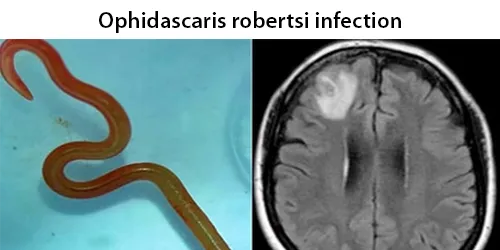
• Cacing Guinea / Dracunculiasis
Masa Dormansi: Satu tahun atau lebih. Tanda-tanda pertama dracunculiasis terjadi sekitar satu tahun setelah infeksi, saat cacing betina dewasa bersiap meninggalkan tubuh orang yang terinfeksi.
Sekitar satu tahun setelah infeksi awal, cacing betina bermigrasi ke kulit, membentuk bisul, dan muncul. Ketika luka tersebut menyentuh air tawar, cacing betina akan memuntahkan cairan berwarna putih susu yang mengandung ratusan ribu larva ke dalam air. Selama beberapa hari setelah keluar dari luka, si betina akan terus mengeluarkan larva ke dalam air di sekitarnya. Larva-larva tersebut dimakan oleh copepoda (krustasea air kecil), dan setelah dua hingga tiga minggu perkembangannya, mereka kembali menular ke manusia.
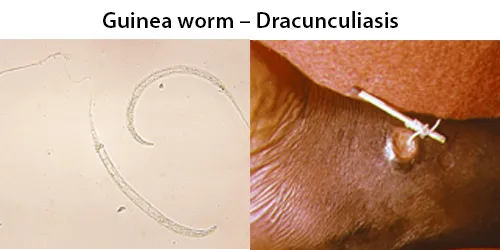
• Cacing Kremi – Enterobiasis
Masa Dormansi: Hingga 8 minggu, seringkali tanpa gejala.
Penyakit ini disebarkan di antara manusia melalui telur cacing kremi. Telur-telur tersebut awalnya muncul di sekitar anus. Jangka waktu dari menelan telur hingga munculnya telur baru di sekitar anus adalah 4 hingga 8 minggu. Gejala utamanya adalah gatal-gatal di dalam dan di sekitar anus dan perineum. Sepertiga orang dengan infeksi cacing kremi sama sekali tidak menunjukkan gejala. Telur cacing kremi sangat kuat dan dapat tetap menular, di luar tubuh, di lingkungan yang lembab hingga tiga minggu.
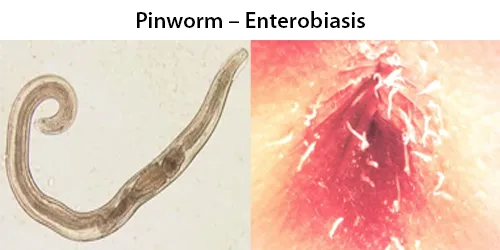
• Gnathostomiasis
Masa Dormansi: Hingga 4 minggu.
Gnathostomiasis ditularkan melalui konsumsi larva tahap ketiga dari inang perantara atau paratenik kedua yang mentah atau tidak cukup matang, seperti ikan air tawar, ular, unggas, atau katak. Masa inkubasi gnathostomiasis adalah 3-4 minggu ketika larva mulai bermigrasi melalui jaringan subkutan tubuh.
Beberapa hari setelah konsumsi, nyeri epigastrium, demam, muntah, dan kehilangan nafsu makan akibat migrasi larva melalui dinding usus ke rongga perut akan muncul pada pasien.
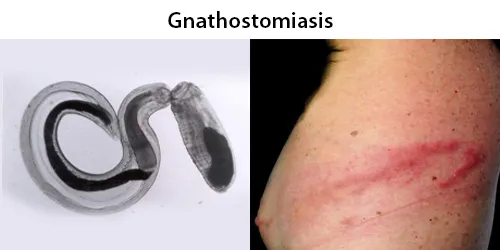
• Halicephalobiasis
Masa Dormansi: Mungkin beberapa hari hingga beberapa minggu.
Halicephalobus gingivalis adalah spesies nematoda saprofit yang hidup bebas. Ini adalah parasit fakultatif pada kuda, menyerang rongga hidung, dan kadang-kadang banyak daerah lain, di mana ia menghasilkan massa granulomatosa.
Pada kesempatan yang jarang terjadi, nematoda ini juga dapat menginfeksi manusia, menyebabkan meningoencephalitis yang mematikan. Infeksi pada otak sering terjadi, diikuti oleh ginjal, rongga mulut dan hidung, kelenjar getah bening, paru-paru, sumsum tulang belakang, dan kelenjar adrenal, dan juga dilaporkan adanya infeksi pada jantung, hati, lambung dan tulang.
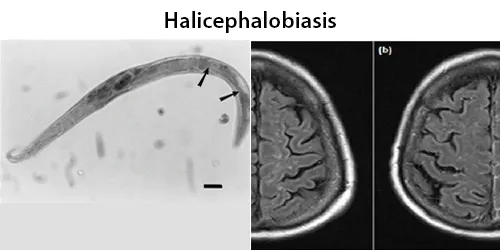
• Loa loa filariasis
Masa Dormansi: Hingga 1 tahun.
Loa loa Filariasis, (Loiasis) adalah penyakit kulit dan mata yang disebabkan oleh cacing nematoda Loa loa. Manusia tertular penyakit ini melalui gigitan lalat rusa (Chrysops spp.) atau lalat mangga. Pembawa penyakit ini menghisap darah dan menggigit di siang hari, dan mereka ditemukan di lingkungan seperti hutan hujan di Afrika bagian barat dan tengah.
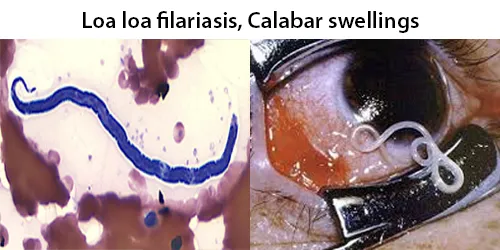
• Mansonelliasis, filariasis
Masa Dormansi: Beberapa hari hingga beberapa minggu.
Infeksi cacing gelang ini biasanya tidak menimbulkan gejala yang jelas, tetapi kadang-kadang dapat menyebabkan dermatitis ringan pada dada dan bahu. Infeksi M. streptocerca untungnya tidak menyebabkan bintil-bintil, penyakit kulit, atau infeksi mata seperti yang terjadi pada Onchocerca volvulus. Namun, infeksi ini dapat terlihat tepat di bawah permukaan kulit, dan mungkin dapat menurunkan kesehatan dan kekebalan kulit.
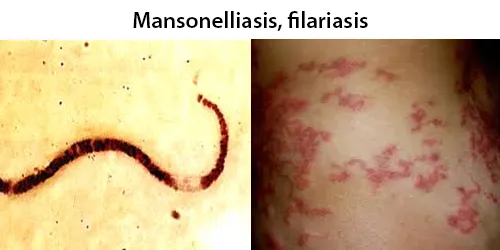
• River blindness, onchocerciasis
Masa Dormansi: 12 bulan hingga 15 tahun.
Umur rata-rata cacing dewasa adalah 15 tahun, dan cacing betina dewasa dapat menghasilkan antara 500 hingga 1.500 mikrofilaria per hari. Umur mikrofilaria normal adalah 1,0 hingga 1,5 tahun; namun, keberadaan mereka dalam aliran darah menyebabkan sedikit atau tidak ada respon imun sampai kematian atau degradasi mikrofilaria atau cacing dewasa. Cacing ini menyebar dari orang ke orang melalui lalat hitam betina yang menggigit dari genus Simulium, dan manusia adalah satu-satunya inang definitif yang diketahui.
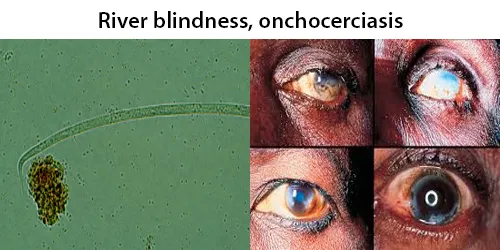
• Strongyloidiasis – Pneumonia Parasit
Masa Dormansi: Seumur hidup pasien.
Tahap parasit dewasa hidup di terowongan di mukosa usus kecil. Banyak orang yang terinfeksi tidak menunjukkan gejala pada awalnya. Gejalanya meliputi dermatitis: bengkak, gatal, larva currens, dan perdarahan ringan di tempat di mana kulit telah ditembus. Lesi seperti goresan spontan dapat terlihat di wajah atau di tempat lain. Jika parasit mencapai paru-paru, dada mungkin terasa seperti terbakar, dan mengi serta batuk dapat terjadi, bersama dengan gejala seperti pneumonia (sindrom Löffler). Usus pada akhirnya dapat diserang, menyebabkan rasa sakit seperti terbakar, kerusakan jaringan, sepsis, dan bisul.
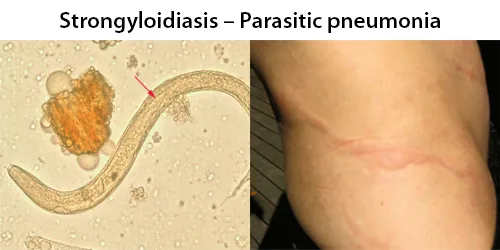
• Thelaziasis, Cacing Mata
Masa Dormansi: Beberapa hari hingga 1 tahun.
Thelaziasis adalah istilah untuk infestasi nematoda parasit dari genus Thelazia. Semua spesies Thelazia dewasa yang ditemukan sejauh ini mendiami mata dan jaringan terkait (seperti kelopak mata, saluran air mata, dll.) dari berbagai inang mamalia dan burung, termasuk manusia. Nematoda Thelazia sering disebut sebagai “cacing mata”. Pada inang hewan dan manusia, infestasi Thelazia mungkin tidak bergejala, meskipun sering menyebabkan mata berair (epifora), konjungtivitis, kekeruhan kornea, atau ulkus kornea (keratitis ulseratif). Manusia yang terinfeksi juga telah melaporkan “sensasi benda asing” – perasaan ada sesuatu di dalam mata.
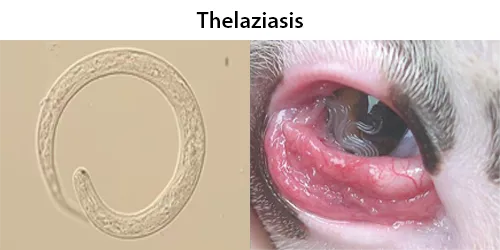
• Toxocariasis
Masa Dormansi: 2 minggu hingga beberapa tahun.
Toksokariasis adalah penyakit pada manusia yang disebabkan oleh cacing gelang anjing (Toxocara canis) dan, yang lebih jarang, cacing gelang kucing (Toxocara cati). Cacing gelang usus yang paling umum ditemukan pada anjing, anjing hutan, serigala, rubah, dan kucing peliharaan. Manusia adalah salah satu dari sekian banyak inang yang “tidak disengaja” atau paratenik dari cacing gelang ini.
Meskipun infeksi zoonosis ini biasanya tidak menunjukkan gejala, infeksi ini dapat menyebabkan penyakit yang parah.
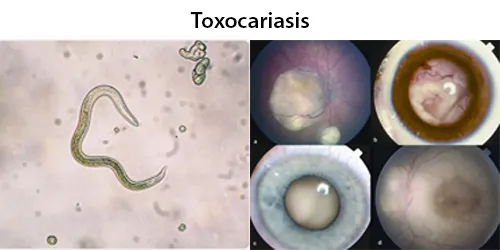
• Trikinosis
Masa Dormansi: Hingga 7 hari.
Sekitar 11 juta manusia terinfeksi Trichinella. Sebagian besar infeksi trikinosis hanya memiliki gejala ringan atau tanpa gejala dan tanpa komplikasi. Selama infeksi awal, invasi pada usus dapat menyebabkan diare, sakit perut, dan muntah. Migrasi larva ke otot, yang terjadi sekitar seminggu setelah terinfeksi, dapat menyebabkan pembengkakan pada wajah, radang bagian putih mata, demam, nyeri otot, dan ruam. Komplikasi dapat mencakup radang otot jantung, keterlibatan sistem saraf pusat, dan radang paru-paru.

• Cacing Cambuk
Masa Dormansi: 3 bulan, hingga 1 tahun atau lebih.
Selama sekitar empat minggu, cacing cambuk memakan pembuluh darah yang terletak di dalam sekum usus besar. Akhirnya, cacing cambuk meninggalkan sekum dan mulai bertelur ribuan telur. Telur-telur yang belum berembrio ini kemudian dilepaskan dari inangnya melalui feses. Proses dari menelan telur hingga keluar membutuhkan waktu sekitar 12 minggu. Telur yang dilepaskan akan berembrio dalam waktu sekitar sembilan hingga dua puluh satu hari dan akhirnya tertelan oleh inang lain. Telur yang dikeluarkan melalui feses, dapat tetap hidup di dalam tanah selama bertahun-tahun.
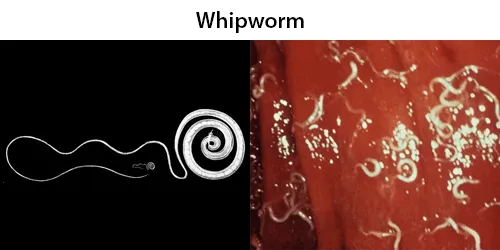
- Endoparasit
Endoparasit dan Patogen yang Ditularkan Melalui Feses
• Amoebiasis
Periode Dormansi: Beberapa hari hingga beberapa minggu, tetapi biasanya sekitar dua hingga empat minggu.
Sebagian besar orang yang terinfeksi, sekitar 90%, tidak menunjukkan gejala, tetapi penyakit ini berpotensi menjadi serius. Diperkirakan sekitar 40.000 hingga 100.000 orang di seluruh dunia meninggal setiap tahun akibat amoebiasis.
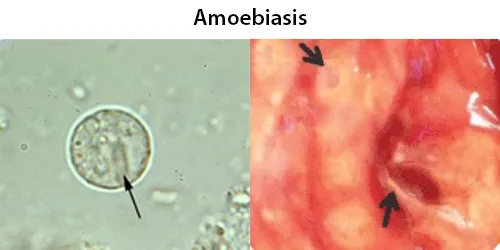
• Balantidiasis
Periode dormansi : berhari-hari sampai bertahun-tahun.
Balantidiasis adalah penyakit zoonosis yang diperoleh manusia melalui rute fekal-oral dari inang normal, yaitu babi, di mana penyakit ini tidak menunjukkan gejala. Makanan dan air yang terkontaminasi feses adalah sumber infeksi yang umum pada manusia.
Beberapa orang yang terinfeksi Balantidiasis mungkin tidak menunjukkan gejala atau hanya mengalami diare ringan dan ketidaknyamanan perut, tetapi yang lain dapat mengalami gejala yang lebih parah yang mirip dengan peradangan akut pada usus.
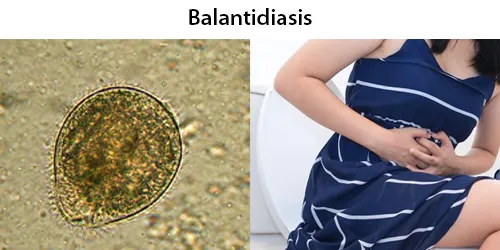
• Blastosistosis
Periode Dormansi: Minggu hingga tahun.
Blastocystis adalah parasit protozoa bersel tunggal yang hidup di saluran pencernaan manusia dan hewan lainnya. Ada berbagai jenis Blastocystis, dan mereka dapat menginfeksi manusia, hewan ternak, burung, rodensia, amfibi, reptil, ikan, dan bahkan kecoa. Blastosistosis ditemukan sebagai faktor risiko yang mungkin untuk perkembangan sindrom iritasi usus besar (IBS).
Kejadian umum dari Blastocystosis dapat bersifat tanpa gejala maupun dengan gejala. Sebagian besar kasus infeksi ini tampaknya didiagnosis sebagai sindrom iritasi usus besar.
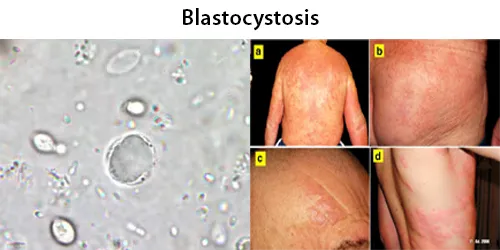
• Kriptosporidiosis
Masa Dormansi: 2 – 28 hari.
Kriptosporidiosis, kadang-kadang secara informal disebut kripto, adalah penyakit parasit yang disebabkan oleh Cryptosporidium, sebuah genus parasit protozoa dalam filum Apicomplexa. Penyakit ini menyerang usus halus bagian distal dan dapat memengaruhi saluran pernapasan pada orang yang memiliki kekebalan tubuh yang baik (yaitu, orang yang memiliki sistem kekebalan tubuh yang berfungsi normal) dan orang yang mengalami gangguan kekebalan tubuh (misalnya, orang dengan HIV / AIDS atau gangguan autoimun), yang mengakibatkan diare berair dengan atau tanpa batuk yang tidak dapat dijelaskan.
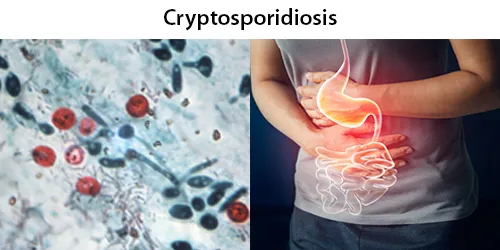
• Cyclosporiasis
Masa Inkubasi: 1 minggu
Cyclosporiasis terutama menyerang manusia dan primata lainnya. Ketika ookista Cyclospora cayetanensis memasuki usus kecil, ia menyerang mukosa, di mana ia berinkubasi selama sekitar satu minggu. Setelah inkubasi, orang yang terinfeksi mulai mengalami diare berair yang parah, kembung, demam, kram perut, dan nyeri otot.
Cyclosporiasis adalah penyakit yang disebabkan oleh infeksi Cyclospora cayetanensis, sebuah protozoa apikompleks patogen yang ditularkan melalui feses atau makanan dan air yang terkontaminasi feses.
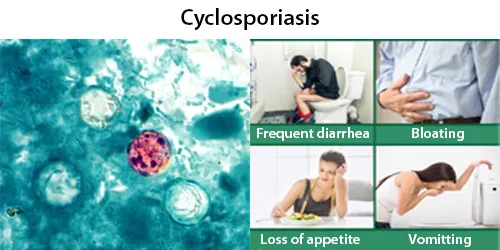
• Dientamoebiasis
Masa Inkubasi: berhari-hari.
Dientamoebiasis adalah kondisi medis yang disebabkan oleh infeksi Dientamoeba fragilis, parasit sel tunggal yang menginfeksi saluran pencernaan bagian bawah manusia. Ini adalah penyebab penting dari diare pada wisatawan, sakit perut kronis, kelelahan kronis, dan kegagalan tumbuh kembang pada anak-anak.
Banyak orang yang merupakan pembawa Dientamoebiasis fragilis tanpa gejala. Terdapat varian patogen dan non-patogen. Umumnya dianggap tidak berbahaya jika dalam populasi yang seimbang.
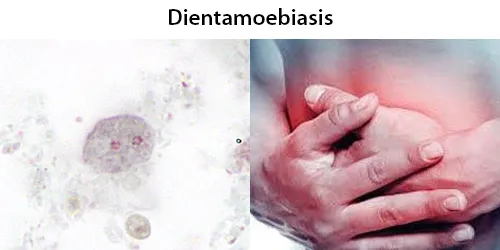
• Giardiasis
Masa Dormansi: Hingga tiga minggu, tanpa gejala selama berminggu-minggu.
Giardiasis adalah penyakit parasit yang disebabkan oleh Giardia duodenalis (juga dikenal sebagai G. lamblia dan G. intestinalis). Individu yang terinfeksi yang mengalami gejala (sekitar 10% tidak memiliki gejala) dapat mengalami diare, sakit perut, dan penurunan berat badan. Gejala yang lebih jarang terjadi adalah muntah dan darah dalam tinja. Gejala biasanya dimulai satu hingga tiga minggu setelah terpapar dan, tanpa pengobatan, dapat berlangsung selama dua hingga enam minggu atau lebih.
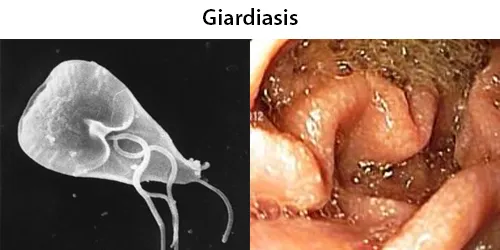
• Isosporiasis
Masa Dormansi: berhari-hari.
Isosporiasis, juga dikenal sebagai cystoisosporiasis, adalah penyakit usus manusia yang disebabkan oleh parasit. Infeksi sering terjadi pada individu yang memiliki sistem kekebalan tubuh yang lemah, terutama pasien AIDS. Biasanya menyebar secara tidak langsung, biasanya melalui makanan atau air yang terkontaminasi. Inang yang terinfeksi kemudian menghasilkan bentuk parasit yang belum matang dalam tinja mereka, dan ketika parasit matang, ia mampu menginfeksi inang berikutnya, melalui makanan atau air yang mengandung parasit.
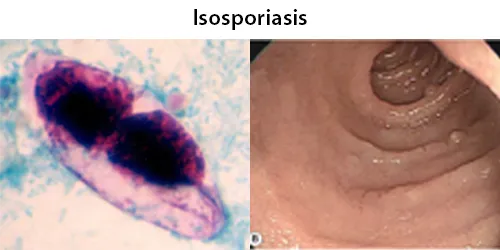
• Leishmaniasis
Masa Dormansi: Beberapa hari hingga beberapa minggu hingga beberapa bulan.
Leishmaniasis adalah beragam manifestasi klinis yang disebabkan oleh parasit protozoa dari genus Trypanosomatida, yaitu Leishmania. Penyakit ini umumnya menyebar melalui gigitan lalat pasir phlebotomine, Phlebotomus dan Lutzomyia, dan paling sering terjadi di daerah tropis dan sub-tropis di Afrika, Asia, Amerika, dan Eropa selatan. Penyakit ini dapat muncul dalam tiga cara utama: kulit, mukosa, atau viseral.

• Primary amoebic meningo-encephalitis (PAM)
Masa Dormansi: Hingga 12 hari, kematian hingga dua minggu setelah paparan. Diagnosis dini dan akurat sangat penting.
Naegleria fowleri, juga dikenal sebagai amuba pemakan otak. Mikroorganisme yang hidup bebas ini terutama memakan bakteri tetapi dapat menjadi patogen pada manusia, menyebabkan infeksi otak yang sangat langka, tiba-tiba, parah, dan biasanya fatal yang dikenal sebagai naegleriasis atau meningoencephalitis amuba primer (PAM).
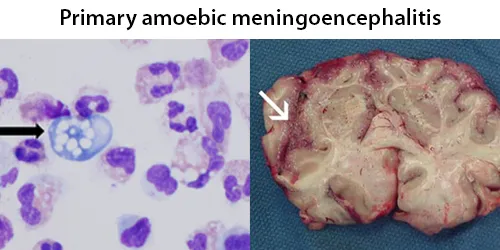
Endoparasit dan Patogen yang Ditularkan Melalui Darah dan Udara
• Babesiosis
Periode Dormansi: Hingga 9 minggu, atau sepanjang hidup pasien jika tanpa gejala.
Orang dapat terinfeksi parasit Babesia melalui gigitan caplak yang terinfeksi, melalui transfusi darah dari donor yang terinfeksi produk darah, atau melalui transmisi kongenital (dari ibu yang terinfeksi ke bayinya). Caplak menularkan strain babesiosis pada manusia, sehingga sering kali disertai dengan penyakit lain yang ditularkan oleh caplak seperti penyakit Lyme.
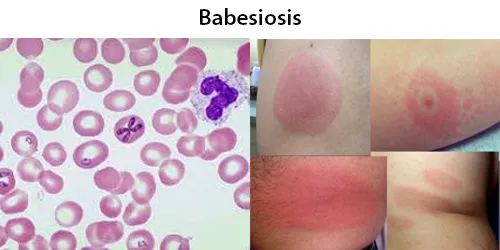
• Penyakit Chagas
Periode Dormansi: 2 bulan hingga beberapa tahun.
Diperkirakan 6 hingga 7 juta orang di seluruh dunia terinfeksi penyakit Chagas T. cruzi. Penyakit Chagas disebabkan oleh infeksi parasit protozoa T. cruzi, yang biasanya ditularkan ke manusia melalui gigitan serangga triatomine, yang juga disebut “kissing bugs”. Ketika serangga tersebut membuang kotorannya di tempat gigitan, bentuk T. cruzi motil yang disebut trypomastigotes masuk ke dalam aliran darah dan menyerang berbagai sel inang. Selama bertahun-tahun, siklus replikasi parasit dan respons kekebalan tubuh dapat merusak jaringan-jaringan ini, terutama jantung dan saluran pencernaan.
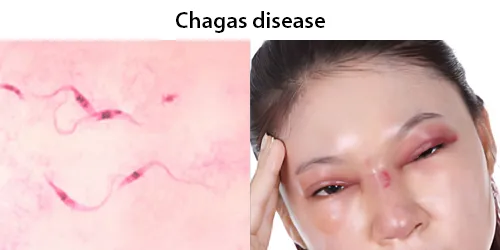
• Granulomatous amoebic encephalitis
Masa Dormansi: Beberapa hari hingga beberapa minggu.
Balamuthia mandrillaris adalah amuba yang hidup bebas yang menyebabkan kondisi neurologis yang langka namun mematikan, yaitu granulomatous amoebic encephalitis (GAE). B. mandrillaris dapat menginfeksi tubuh melalui luka terbuka atau mungkin melalui penghirupan. B. mandrillaris tersebar di seluruh wilayah beriklim sedang di dunia.
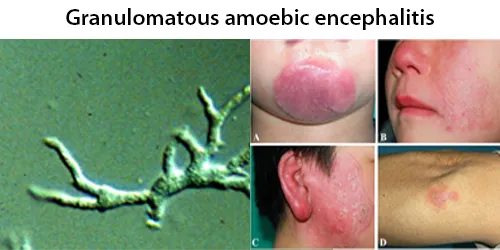
• Granulomatous amoebic encephalitis and Acanthamoeba keratitis (infeksi mata)
Masa Dormansi: 1 minggu hingga berbulan-bulan.
Acanthamoeba spp. adalah salah satu protozoa yang paling banyak ditemukan di lingkungan. Mereka tersebar di seluruh dunia, dan telah diisolasi dari tanah, udara, limbah, air laut, kolam renang yang diklorinasi, air keran rumah tangga, air kemasan, unit perawatan gigi, rumah sakit, unit pendingin ruangan, dan kotak lensa kontak. Selain itu, mereka telah diisolasi dari kulit manusia, rongga hidung, tenggorokan, dan usus, serta tanaman dan mamalia lainnya.
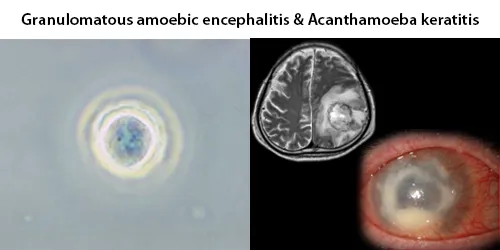
• Malaria
Masa Dormansi: Hingga 24 minggu setelah gejala awal.
Malaria pada manusia disebabkan oleh mikroorganisme bersel tunggal dari kelompok Plasmodium. Penyakit ini disebarkan secara eksklusif melalui gigitan nyamuk Anopheles betina yang terinfeksi. Gigitan nyamuk memasukkan parasit dari air liur nyamuk ke dalam darah seseorang. Parasit berjalan ke hati, di mana mereka menjadi dewasa dan berkembang biak.

• Rhinosporidiosis
Masa Dormansi: Dapat tetap menjadi jamur yang tidak aktif selama bertahun-tahun.
Organisme ini menginfeksi mukosa rongga hidung, menghasilkan lesi seperti massa. Massa ini tampak seperti polipoidal dengan permukaan granular yang berbintik-bintik dengan spora keputihan. Massa rinosporidial secara klasik digambarkan sebagai massa murbei seperti stroberi. Massa ini dapat meluas dari rongga hidung ke dalam nasofaring dan muncul di rongga mulut. Lesi ini biasanya menyebabkan perdarahan dari rongga hidung. R. seeberi juga dapat mempengaruhi kelenjar air mata dan juga jarang mempengaruhi kulit dan alat kelamin.

• Sarkosistosis
Masa Dormansi: Hingga 60 hari. Banyak yang tidak menunjukkan gejala.
Jika timbul gejala, biasanya terjadi 20-40 hari setelah menelan sporokista dan selama migrasi sporozoit berikutnya melalui pembuluh darah. Lesi akut (edema, perdarahan, dan nekrosis) berkembang di jaringan yang terkena. Parasit ini memiliki kecenderungan untuk menyerang otot rangka (miositis), otot jantung (perdarahan petekie pada otot jantung dan serosa), dan kelenjar getah bening (edema, nekrosis, dan perdarahan).
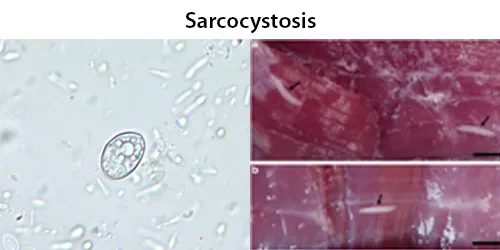
• Penyakit Tidur
Masa Dormansi: Tidak diketahui.
T. brucei ditularkan di antara inang mamalia oleh vektor serangga yang termasuk dalam spesies lalat tsetse yang berbeda (Glossina). Penularan terjadi melalui gigitan saat serangga memakan darah. Trypanosoma brucei adalah spesies kinetoplastid parasit yang termasuk dalam genus Trypanosoma yang ada di sub-Sahara Afrika. Tidak seperti parasit protozoa lainnya yang biasanya menginfeksi sel darah dan jaringan, Trypanosoma brucei secara eksklusif berada di luar sel dan mendiami plasma darah dan cairan tubuh.
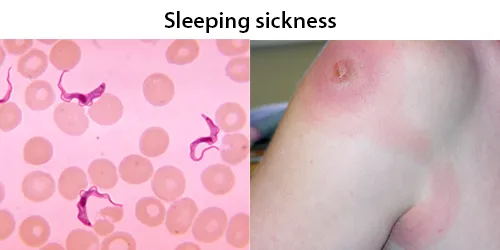
• Toksoplasmosis (Akut & Laten)
Masa Dormansi: 7-10 hari, atau dalam masa dormansi seumur hidup pasien.
Ditemukan di seluruh dunia, T. gondii mampu menginfeksi hampir semua hewan berdarah panas. Pada manusia, terutama bayi dan mereka yang memiliki kekebalan tubuh yang lemah, infeksi T. gondii umumnya tidak menunjukkan gejala tetapi dapat menyebabkan kasus toksoplasmosis yang serius. T. gondii pada awalnya dapat menyebabkan gejala ringan seperti flu dalam beberapa minggu pertama setelah paparan, tetapi sebaliknya, orang dewasa yang sehat tidak menunjukkan gejala.

• Trikomoniasis
Masa Dormansi: Beberapa tahun pada pasien tanpa gejala.
Trichomonas adalah genus parasit gali anaerobik, dan diperkirakan merupakan IMS non-virus yang paling banyak ditemukan di seluruh dunia. Tingkat infeksi pada pria dan wanita serupa, tetapi wanita biasanya bergejala, sedangkan infeksi pada pria biasanya tidak bergejala. Penularan biasanya terjadi melalui kontak langsung dari kulit ke kulit dengan orang yang terinfeksi, paling sering melalui hubungan seksual. 160 juta kasus infeksi terjadi setiap tahunnya di seluruh dunia.

Kenapa Deep Dive?
Bersikap proaktif.
Pastikan masa depan yang sehat.
• Identifikasi patogen terpendam yang tidak biasanya diuji di tempat lain.
Terlalu sering kita mungkin menjadi inang parasit dan telurnya, menyebabkan efek yang meningkat secara bertahap, selama berminggu-minggu atau bahkan bertahun-tahun - dan kemudian meledak menjadi penyakit yang tidak terduga. Mungkin kita tidak tahu bahwa kita membawa penyakit itu sendiri, tetapi justru menderita akibat efek sampingnya.
• Identifikasi penyebab penyakit saluran pencernaan, hati, dan pankreas.
Banyak dari parasit dan patogen yang diuji di sini adalah penyebab utama kanker pencernaan dan penyakit melemahkan lainnya, gas kronis atau kembung, perdarahan dan gatal di area anus, serta penyumbatan usus.
• Temukan penyebab gejala yang mempengaruhi sistem saraf dan otak.
Gejala seperti sakit kepala berkepanjangan, masalah kesehatan mental, kejang, disorientasi, kurangnya koordinasi, kehilangan perasaan, ketidakstabilan hormon, dan lainnya, dapat menunjukkan parasit yang asimptomatik atau terpendam serta penyakit yang mereka sebabkan pada otak atau sistem saraf.
• Identifikasi penyebab masalah reproduksi.
Ketidak-suburan pada pria dan wanita, menstruasi berat, kurangnya menstruasi, disfungsi ereksi pada pria, kadang-kadang disebabkan oleh parasit dan kerusakan yang mereka timbulkan dalam jangka panjang.
• Temukan penyebab efek demam, kelelahan, ruam kulit, gatal konstan, nyeri otot.
Parasit dapat masuk ke dalam tubuh melalui kulit, dan beredar melalui darah dan cairan limfatik. Dalam perjalanannya, mereka meninggalkan racun dan limbah yang menyebabkan iritasi, menjadi penyimpanan kistik, yang dapat menjadi penyakit jangka panjang.
• Cari penyebab masalah paru-paru dan pernapasan.
Beberapa jenis parasit memasuki paru-paru, mengkonsumsi, meracuni, dan merusak jaringan paru-paru dan saluran udara yang halus, sering kali salah didiagnosis sebagai alergi.
• Temukan dasar dan penyebab nyata dari sebagian besar kanker.
Jarang sekali dokter berbicara tentang parasit sebagai penyebab terbesar kanker dan penyakit jaringan. Topik ini hampir diabaikan di sekolah kedokteran.
Tanda & Gejala Parasit Dalam Atau Pada Tubuh
- Diare konstan
- Sakit perut
- Gas dan kembung
- Serat atau lendir dalam feses
- Mual
- Penurunan berat badan yang tidak disengaja
- Nafsu makan meningkat
- Dehidrasi
- Kedinginan
- Demam
- Nyeri otot
- Ruam
- Lesi kulit yang tidak biasa
- Insomnia
- Kaku rahang
- Aritmia jantung
- Pergerakan atau elevasi aneh di bawah kulit
- Gatal di sekitar anus
- Alergi dari segala jenis
- Ketombe yang konstan
- Feses berdarah
- Sakit saat urinasi/BAK
- Lendir konstan dari paru-paru
- Infeksi mata

Pencegahan
- Masak semua daging dan makanan untuk membunuh telur dan parasit
- Hindari makanan mentah, terutama di daerah tropis
- Hindari makanan olahan pabrik
- Hindari berjalan tanpa alas kaki, terutama jika ada luka atau lecet.
- Selalu cari air minum yang aman
- Hindari kolam renang yang tidak terklorin dengan baik
- Hindari sungai dan muara sungai, karena parasit, tetapi juga polusi kimia yang menurunkan kekebalan tubuh
- Lindungi diri Anda dari gigitan serangga.
- Kenakan pakaian pelindung, gunakan semprotan serangga, dan tidurlah di bawah kelambu jika perlu
- Hati-hati dengan apa yang Anda garuk. Telur dan kista dapat hidup di bawah kuku selama berjam-jam, langsung menginokulasi kulit/mata/kepala
Petunjuk Penting Pengumpulan Feses
Bacalah semua petunjuk ini sebelum Anda memulai pengumpulan feses. Kesalahan dapat menyebabkan analisa yang salah dan memerlukan pengujian ulang. Persiapan
Persiapan
1 bulan sebelum melakukan tes…
- Idealnya tunggu 4 minggu setelah minum antibiotik atau obat anti-parasit sebelum Anda melakukan tes.
4 hari sebelum tes…
- Jalani pola makan normal Anda setidaknya selama 4 hari sebelum melakukan tes.
- Berhenti mengonsumsi probiotik 4 hari sebelum Anda mengikuti tes.
- Berhenti makan daging merah dan sayuran mentah 4 hari sebelum tes.
- Jangan gunakan obat pencahar, termasuk minyak mineral dan minyak jarak, setidaknya selama 4 hari sebelum tes.
- Jangan mengonsumsi pengganti lemak sintetis, seperti Olestra.
- Jangan mengonsumsi suplemen nutrisi penghambat lemak.
Hari pengujian
- Wanita yang sedang menstruasi harus menunggu sampai semuanya bersih sebelum melakukan tes.
- Beritahukan kepada petugas jika terjadi perdarahan di area genital.
- Beritahukan kepada staf medis jika Anda sedang mengonsumsi obat pereda nyeri NSAID atau aspirin.
- Beritahukan kepada petugas medis jika Anda mengalami diare atau perubahan lain dalam buang air besar.
Prosedur Pengumpulan Sampel Feses
- Sampel feses tidak boleh mengandung kontaminasi dari urin, darah menstruasi, obat-obatan, krem, pelumas, dll.
- Bersihkan pembersih toilet dan siram toilet dua kali sebelum memulai tes. Pembersih toilet atau asap dapat menyebabkan hasil yang tidak akurat.
- Feses harus disimpan dan ditempatkan menggunakan wadah hijau yang disediakan, untuk menghindari degradasi atau kontaminasi. Suhu rendah dan kegelapan pada sampel harus dipertahankan.
- Buang air kecil terlebih dahulu sebelum mengumpulkan sampel feses, untuk menghindari kontaminasi dari urin.
- Penangkap feses tidak boleh dipasang di toilet sampai setelah buang air kecil dan menyiramnya.
Petunjuk Pengumpulan Feses
- Buang air kecil terlebih dahulu sebelum mengumpulkan feses – hindari kontaminasi urin pada sampel.
- Cuci tangan secara menyeluruh dengan sabun dan air sebelum memulai proses pengumpulan.
- Buka wadah penampung yang disediakan dalam kit dan siapkan.
- Tempelkan kertas Penangkap Feses ke dudukan toilet.
- Keluarkan seluruh bagian feses ke dalam penangkap feses. Feses padat atau cair dapat dikumpulkan.
a) Tolong – JANGAN GUNAKAN tisu toilet, dll.
b) Angkat seluruh sampel, dan letakkan di dalam kantong hitam dengan kedua tangan.
c) Silakan semprotkan tinja dengan seluruh isi penyemprot formalin, lalu tutup kantong dengan rapat, di dalam kotak sampel berwarna hijau.
d) Selesaikan keperluan Anda seperti biasa.
e) Tutup kotak sampel hijau dengan aman.
f) Cuci tangan Anda.
- Simpan sampel di tempat yang sejuk atau dinginkan jika diinstruksikan oleh staf BSI.
- Berikan kotak sampel kepada perawat di BSI sesegera mungkin, dalam waktu 30 menit jika memungkinkan.
Setibanya di BSI, Anda akan diminta untuk memberikan …
Sampel Darah
Perawat akan meminta sampel darah dari Anda di klinik, bukan dari rumah.
Sampel Urin
Perawat akan meminta sampel darah dari Anda di klinik, bukan dari rumah.
Pemeriksaan Kulit & Kulit Kepala
Dokter akan memeriksa dan mengambil foto berbagai area kulit Anda.
Bagaimana selanjutnya ?
Laboratorium BSI akan memberikan hasil pengujian yang lengkap dengan foto dan analisis.
Hasilnya akan tersedia dalam waktu 5 hari kerja setelah pengambilan sampel awal.
Therapure Nutraceuticals yang mungkin diresepkan bersamaan untuk penyakit yang tercantum ini
Infus IV dengan..
- Sodium Askorbat Vitamin C
- Compound ID Homeopathic Neem
- Compound IL Homeopathic Kulit Manggis
- Compound IP Homeopathic Daun Sirsak
- Compound IS Silver Hidrosol
- DMSO
- Magnesium Sulfat
- Glutation
- NAC
- Vitamin B Complex
- dan lainnya…
Jamu Jo Tonik Oral
- No 5 Bawang Putih
- No 6 Tonik Daun Kenikir
- No 8 Tonik Daun Sirsak
- No 10 Tonik Jintan Hitam
- No 11 Tonik Kulit Buah Mangga
- No 13 Tonik Belalai Gajah
- No 14 Tonik Bunga Lawang
- No 15 Tonik Sambiloto
Nutraseutikal Oral
- Compound DNG Obat Dengue dan Parasit Darah
- Compound MAL Obat Malaria
- Compound PAR-D Parasit Pencernaan dan Darah Multiseluler
- Compound PAR-M Parasit Mikroba dalam Pencernaan atau Darah
- Compound ABO Antibiotik Herbal / Anti-patogen
- Compound FNG Anti-Fungal Herbal Kuat
- Compound MET Kelasi Logam Berat
- Compound PRS Psoriasis & Penyakit Kulit
- Compound SIP Penghambat Spike Protein Artifisial
- Compound VIR Moderator Virus
- Probiotik, dan lainnya…
- Compound G Toner Pencernaan Enzimatis
- Compound VL Pembersihan Tonik Pencernaan Nutrisi
- Compound W Penghilang Parasit dan Protozoa
Obat Topikal
- Compound BVC Salep Anti-Patogen untuk Kulit
- Compound C Salep Penyembuhan
- Compound ED Tetes Mata Vitamin C
- Compound O Rebuilder Tulang & Ligamen
- Compound R Terapi Inhalasi
- Paket Kesehatan Mulut
- Compound SL Lotion Penyembuhan Kulit Alami
- Compound SS Pembersih Detox & Purifier Alami
- Paket Mandi Vita Detox Tubuh & Pembersih Kulit
- Sabun Neem Terapi Perawatan Parasit & Sampo
- Jus Serangga Penolak Insektisida Alami




